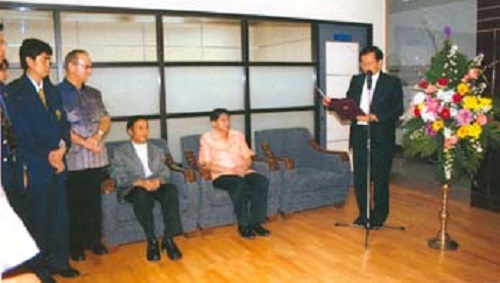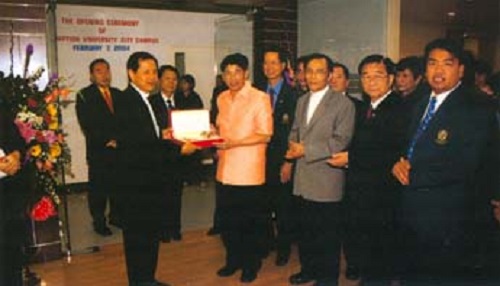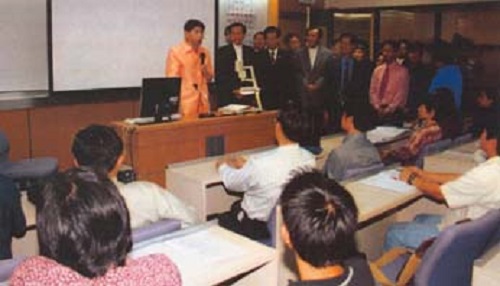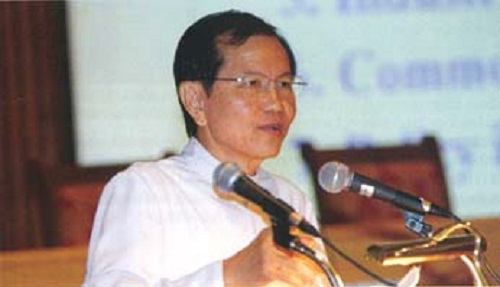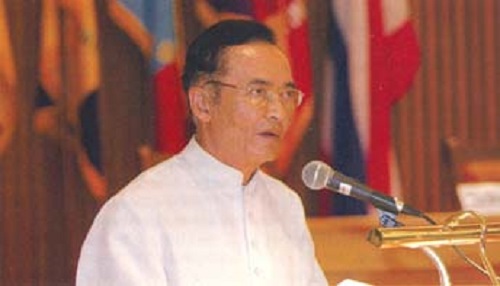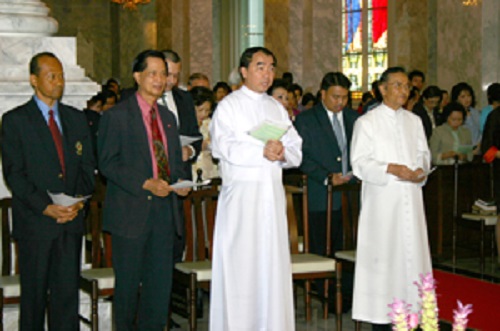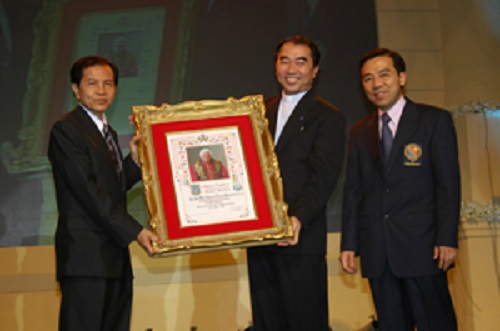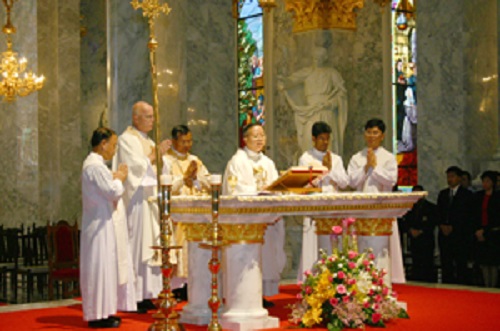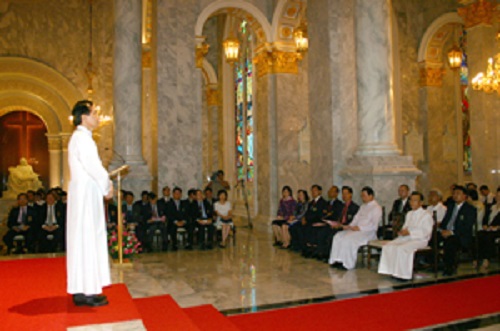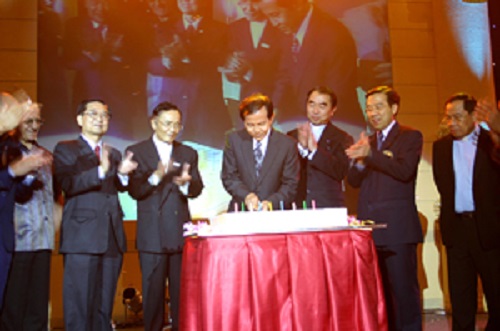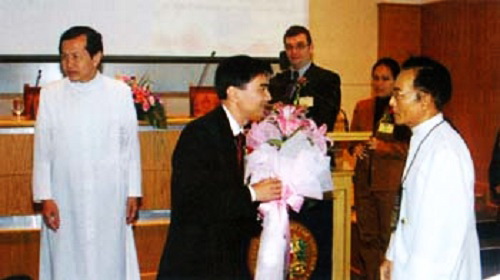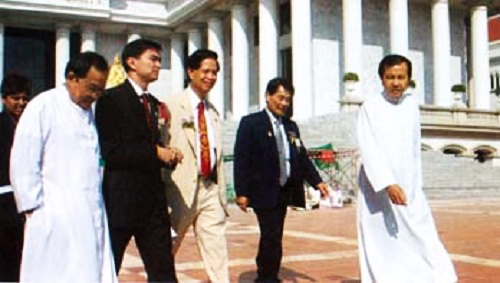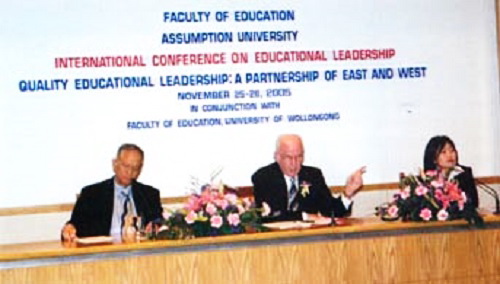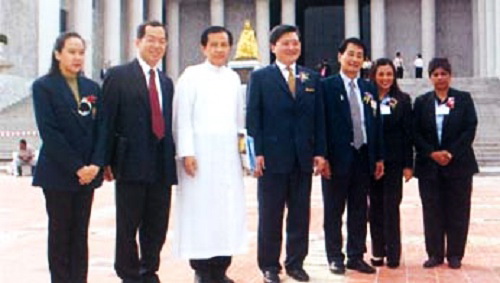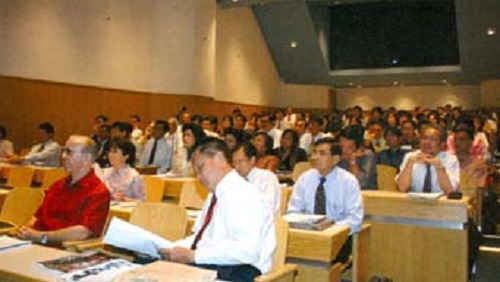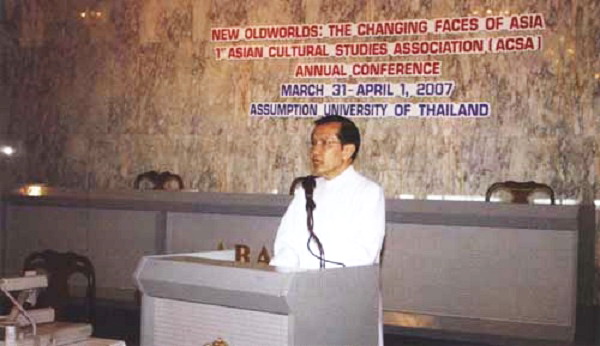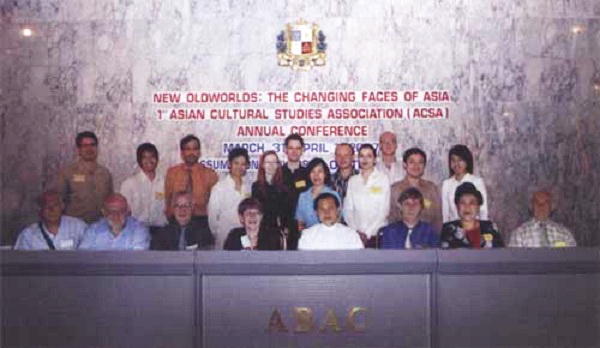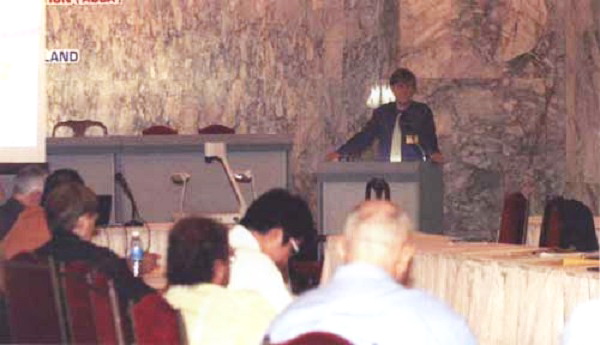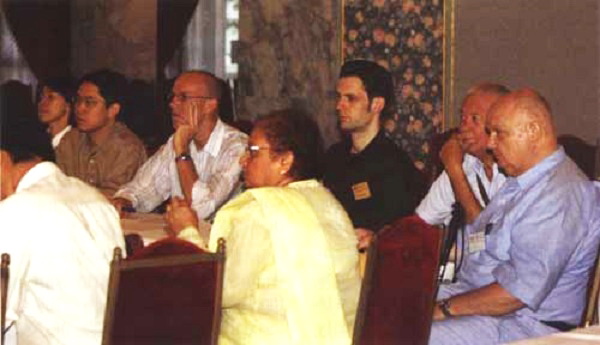Speeches
Speech by AU President Class 36, 2009(READ PDF)
Speech by AU President Class 34, 2007(READ PDF)
Assumption University City Campus Launched.
Speech by President, Dr. Bancha Saenghiran
Your Excellency Prof. Dr.Wissanu Krea-Ngam, Deputy Prime Minister of the Royal Thai Government.
On behalf of Assumption University, I express my grateful thanks to you for giving your precious time to preside over the Opening Ceremony of our City Campus.
Assumption University is a higher education institution administered by the Brothers of St. Gabriel which exists to provide education, knowledge and training to develop human resources of the country. It started modestly in 1972 as an institution called Assumption Business Administration College or ABAC with English as the medium of instruction. The University has grown continuously until it is now recognized as the first International University of Thailand. We currently offer 41 Bachelor, 31 Master and 8 Doctorate Degree Programs with a total enrollment of approximately 20,000 including a component of some 2147 international students from 57 countries of the world. Accordingly we contribute more than 500 million baths annually to the revenues of Thailand and at the same time we save expenditure of several billion baths a year by preventing or restraining students from pursuing education at foreign institutions abroard.
Assumption University is now operating 2 campuses, one each at Hua Mak and Bang Na and performing 4 main missions of the higher education institutions: 1.providing training and instruction, 2.producing research, 3.offering knowledge service to the society and 4.supporting national art and culture.
President Dr. Bancha Saenghiran giving his speech at City Campus in the presence of
Deputy Prime Minister, President Emeritus and other guests.
Deputy Premier H.E. Prof. Dr. Wissanu Krea-Ngam accepting a souvenir from President Dr. Bancha Saenghiran.
In launching this new City Campus at the Emporium Tower, our purpose is to expand knowledge services to society and to enlarge educational opportunities according to the Educational Expansion Policies of Thailand. The City Campus has the following facilities: 50-sear seminar room, 56-seat classroom and_an 18 seal common room with modern teaching materials and equipments.
The first program that the new city campus provides is entitled Vietnam Studies, which is administered by the Institute of Asian and African Studies (IAAS), Assumption University. The objective of the course it to propagate knowledge and education about Vietnam including promotion of its language, traditions, culture, economics and society.
Now it is the auspicious time to invite H.E. the Deputy Prime Minister to preside over the Opening Ceremony of Assumption University City Campus and the Vietnam Studies Centre respectively.
It is with great honour that I preside at the opening of Assumption University City Campus today. I would like to express my sincere appreciation to the University for its strong determination to improve the quality of the human resources of the country, which is vital for the increasingly competitive world in this era of globalization.
Life-long learning is the key aspect of education reform with the main purpose of transforming Thai society into a society of intelligent and prosperous citizens. In order to achieve the goal, the collaboration among the education institutions is very essential. Specifically for higher education institutions, the emphasis should not only be on providing education and instruction to young people, but also on adapting themselves to be ‘Knowledge Centers for Open Learning’ which is beneficial to people of all ages. Therefore, higher education institutions must emphasize on the importance of building into continuing education centers, focusing on the training of business people, entrepreneurs, as well as laborers by setting up the mechanisms to explore the needs of all sectors. Overall, higher education institutions must function as the rallying point for pursuit of knowledge that everyone, regardless of gender, age or profession, can seek and search for so that Thai people can live their life most productively.
The establishment of the City Campus in the heart of downtown Bangkok truly reflects the wisdom of the administrators in seeking investment opportunities an the strong determination of the University to improve the quality of the country’s human resources. ‘Vietnam Studies’ at this campus will not only provide entrepreneurs or interested people with ideas and guidelines on investing in or having business with Vietnam but it will also help improve the economy of our country. In this regard I do hope that the University will consistently offer other useful courses so that Thai people will gain the ideas and concepts to operate business with other countries, which will boost the exports and bring in foreign currency for the economic stability of our country.
Prof. Dr. Wissanu Krea-Ngam cuts the ribbon at the opening ceremony of the
A.U. city Campus in the presence of administrators and guests.
Deputy Prime Minister speaking to students attending the Vietnam Studies Program on February 7, 2004.
Now I would like to take this opportunity to inaugurate Assumption University City Campus and to mark the opening of the ‘Vietnam Studies Centre’. May all endeavours of Assumption University City Campus be successful and prosperous and may you achieve the objectives of the Vietnam Studies Centre.
แหล่งที่มา : ABAC TODAY (Vol. 19 No. 1 January-February 2004) หน้า 15-16
สมเด็จพระเทพรัตนราชสุดาฯ สยามบรมราชกุมารี
เสด็จพระราชดำเนินทรงเปิดอาคาร
“ศรีศักดิ์ จามรมาน สถานเทคโนโลยีสารสนเทศ”
วันศุกร์ที่ 20 สิงหาคม 2547
คำกราบบังคมทูล โดย ภราดาบัญชา แสงหิรัญ อธิการบดีมหาวิทยาลัยอัสสัมชัญ 2547
ขอพระราชทานกราบบังคมทูล ทรงทราบฝ่าละอองพระบาท
ข้าพระพุทธเจ้า ภราดาบัญชา แสงหิรัญ อธิการบดีมหาวิทยาลัยอัสสัมชัญ ในนามของสภามหาวิทยาลัยคณาจารย์ เจ้าหน้าที่ นักศึกษา บรรดานักบวช ผู้ปกครองของนักศึกษา และผู้มีเกียรติที่ได้เฝ้าทูลละอองพระบาทอยู่ ณ สถานที่แห่งนี้ มีความซาบซึ้งและสำนึกในพระมหากรุณาธิคุณเป็นล้นพ้นที่ใต้ฝ่าละอองพระบาทเสด็จพระราชดำเนินมาทรงประกอบพิธีเปิดอาคารศรีศักดิ์ จามรมาน สถานเทคโนโลยีสารสนเทศ และพระราชทานเข็มที่ระลึกแก่ผู้มีอุปการะคุณต่อมหาวิทยาลัย ข้าพระพุทธเจ้า ขอพระราชทานพระวโรกาศ กราบบังคมทูลประวัติและความเป็นมาเกี่ยวกับ อาคารศรีศักดิ์ จามรมาน สถานเทคโนโลยีสารสนเทศ โดยสังเขปดังนี้
มหาวิทยาลัยอัสสัมชัญ เป็นสถาบันการศึกษาระดับอุดมศึกษาของมูลนิธิเซนต์คาเบรียลแห่งประเทศไทย ที่ได้ดำเนินการจัดการศึกษา เพื่อสนองความต้องการส่วนบุคคลและความต้องการของชาติในสาขาวิชาต่างๆอย่างหลากหลาย โดยเฉพาะได้บุกเบิกการพัฒนาบุคลากรทางด้านเทคโนโลยีสารสนเทศด้วยการเริ่มโครงการการจัดหลักสูตรทางด้านบริหารคอมพิวเตอร์ธุรกิจขึ้นในปี พ.ศ.2522 และต่อมาได้จัดสอนในหลักสูตรทางด้านเทคโนโลยีสารสนเทศเพิ่มขึ้นในระดับปริญญาตรี ปริญญาโท และปริญญาเอก จนอาจกล่าวได้ว่ามีหลักสูตรทางด้านเทคโนโลยีสารสนเทศมากที่สุดในประเทศไทย
สังคมโลกปัจจุบัน การผนวกข้อมูลข่าวสารโดยใช้เทคโนโลยีที่ทันสมัยในยุคโลกาภิวัฒน์ ทำให้เกิดการแข่งขันที่รุนแรงและถ้าหากประเทศไทยไม่สามารถจะก้าวให้ทันตามโลกที่เปลี่ยนไป เราก็จะไม่สามารถแข่งขันกับ ชาวโลกได้ โดยนัยนี้มหาวิทยาลัยเห็นว่าการพัฒนาทรัพยากรมนุษย์ให้เหมาะสมกับยุคแห่งการเรียนรู้จึงเป็นสิ่งที่จำเป็นและการอ่านออกเขียนได้ของคนในยุคนี้ก็คือการเรียนรู้ที่จะนำคอมพิวเตอร์มาใช้ในเรื่องต่างๆ ได้อย่างมี ประสิทธิภาพ
มหาวิทยาลัยอัสสัมชัญ โดยชื่อและสถานภาพของ “อัสสัมชัญ” มีความหมายเป็นที่ประจักษ์แก่คนทั่วไปว่าเป็น “ศูนย์รวมที่สถิตขององค์ความรู้” และเนื่องจากมหาวิทยาลัยได้เป็นผู้ร่วมก่อตั้งสมาคมอินเตอร์เน็ตแห่งภาคพื้นเอเชียด้วย จึงมีความเหมาะสมที่มหาวิทยาลัยอัสสัมชัญจะได้จัดสร้างศูนย์แห่งการเรียนรู้และเปิดโอกาสให้ คนทั่วไปทุกระดับชั้น ไม่ว่าจะเป็นเด็กอนุบาล คนหูหนวก คนตาบอด แม้กระทั่งคนชราที่ยังมีขีดความสามารถในการพิมพ์ ได้มีโอกาสมาฝึกการใช้คอมพิวเตอร์ในงานต่างๆ อันเป็นการสร้างสมรรถนะของคนในชาติทางด้านความรู้การใช้คอมพิวเตอร์ ที่อาคารศรีศักดิ์ จามรมาน สถานเทคโนโลยีสารสนเทศ
อาคารศรีศักดิ์ จามรมาน สถานเทคโนโลยีสารสนเทศ เริ่มก่อสร้างเมื่อวันที่ 29 เมษายน พ.ศ. 2545 เป็นอาคาร 10 ชั้น เนื้อที่ทั้งหมด 12,000 ตารางเมตร ค่าใช้จ่ายในการก่อสร้าง 185 ล้านบาท มหาวิทยาลัยได้ ตั้งชื่ออาคารนี้ว่า “ศรีศักดิ์ จามรมาน สถานเทคโนโลยีสารสนเทศ” เพื่อเป็นเกียรติแก่ศาสตราจารย์ ดร. ศรีศักดิ์ จามรมาน ที่เป็นผู้ริเริ่มวางรากฐานและพัฒนาหลักสูตรทางด้านคอมพิวเตอร์และเทคโนโลยีสารสนเทศในระดับปริญญาตรี ปริญญาโทและปริญญาเอก ที่มหาวิทยาลัยอัสสัมชัญตั้งแต่ปีพ.ศ.2522 โดยได้เปิดสอนในหลักสูตรบริหารธุรกิจบัณฑิต สาขาวิชาคอมพิวเตอร์ธุรกิจอันเป็นหลักสูตรแรกของประเทศไทยและได้พัฒนาขยายเพิ่มขึ้น อีกหลายหลักสูตรและหลายสาขาวิชาจนถึงระดับปริญญาเอก
อาคารศรีศักดิ์ จามรมาน สถานเทคโนโลยีสารสนเทศ จะสามารถรองรับการพัฒนาการเรียนการสอนทางด้านเทคโนโลยีสารสนเทศ ของมหาวิทยาลัยได้อย่างกว้างขวางทั้งในปัจจุบัน และในอนาคตจะเป็นศูนย์แห่งความเป็นเลิศด้านการศึกษาไอซีทีเป็นที่ตั้งของวิทยาลัยการศึกษาทางไกลอินเทอร์เน็ต และศูนย์คอมพิวเตอร์ของมหาวิทยาลัย
ด้วยสำนึกในพระมหากรุณาธิคุณของใต้ฝ่าละอองพระบาท ข้าพระพุทธเจ้าในนามของผู้บริหาร คณาจารย์และเจ้าหน้าที่ ขอตั้งสัตย์ปฏิญานต่อใต้ฝ่าละอองพระบาทในวันนี้ว่ามหาวิทยาลัยอัสสัมชัญจะพยายามทำหน้าที่ของสถาบันอุดมศึกษา เพื่อผลิตบุคลากรที่มีคุณภาพออกไปรับใช้ชาติเป็นแหล่งขององค์ความรู้ที่เปิดโอกาสให้บุคคลทั่วไปได้มีโอกาสพัฒนาตนเองทางด้านเทคโนโลยีสารสนเทศเพื่อเป็นรากฐานและกำลังสำคัญในการพัฒนาชาติต่อไป
ด้วยเกล้าด้วยกระหม่อม
Presidential Address
Rev. Bro. Dr.Bancha Saenghiran f.s.g.
President, Assumption University
Honored guests, aistinguished participants, faculty and students:
First and foremost, let me welcome all of you to Assumption University and to this seminar in particular.
In the long history, mankind has always been trying to find peace. Yet, peace seems to be elusiye, defying all our efforts to achieve it. According to historical records, wars usually take the form of a series of military campaigns between two opposing sides involving a dispute over sovereignty, territory, resources, religion, or ideology, amongst other issues. Wars seem as old as human society, and they certainly featured prominently in our recorded history. Many tribal societies engage in internecine strife. and warfare and it is typical for such groups to maintain warrior castes or militias.
Technology has played a role in the evolution of warfare. Inventions contribute to advances in different fields, but modern technology has greatly increased the potential cost and destructiveness of war.
Though at present there is no open or declared war, yet you can see eruptions and outbreaks or hostilities, such as bombings, shootings and other forms of violence in many parts of the world. The instances of belligerence, terrorism, of killings and shootings are too many and too widespread to be cited here. But the uprising in the southern part of Thailand , in provinces such as Pattani, Yala. Narathiwat is much closer to horne and the need to restore peace and harmony to the wartorn areas is an urgent necessily.
Causes of War
If we include conflicts in the delinition of war then disruptions of peace can be observed in many parts of the world. Causes vary depending on location, parties involved and other circumstances. The parties either perceive immediate threat to sovereignty or they may have differences or grievances, an immediate need for essential provisions for survival (such as food, water, and other resources) or a long standing hatred between nations that has built up over a number of years. Religious disputes and ideological differences can also cause wars. We have also seen wars caused by some nations pursuing policies of global domination.
In the modern items we have seen wars launched in pursuit of new markets, of natural resources, and of wealth. In many cases wars serve the interests of the wealthy, the feudal lords or the nobility. Some social activists argue that materialism is the supreme cause of war. According to Malthusian theory, wars are caused by expanding populations and limited resources.
Whatever should be the causes of war, the effects of war are unprecedented casualties and destruction across the theatres of conflict. When asked what kind of weapons would be used to fight World War III, the physicist Albert Einstein replied:
"I know not with what weapons World War III will be fought, but World War IV will be fought with sticks and stones."
Peace is commonly understood to mean the "absence of hostilities". Other definitions include freedom from disputes, harmonious relation and the absence of mental stress or anxiety, as the meaning of the word changes with context. However, there are others who would say that the absence of hostilities would refer to only those hostilities which are evident and that true peace only derives from the mind of each individual. A person's conception of "peace" is often the product of culture and upbringing. Based on realization that independence, freedom and justice is inherent to all nations, peace can be achieved when a nation fulfills its duty to choose, live and respect others.Many believe that peace is more than the absence of certain social maladies. From this perspective, peace requires not only the absence of violence but also the presence of justice, as articulated by world lenders like Mahatma Gandhi and others. Much more broad visions of peace than a mere "absence of war" or even a "presence of justice" require to be framed. Peace does not necessarily have to be something the humans might achieve "some day". Peace must be made an essential condition for humanity- - so that we can create and expand it in small ways in our everyday lives.
Since January 2004 the smoldering Malay Muslim insurgency in southern part of Thailand in the provinces of Pattani, Yala and Narathiwat has surfaced again resulting until now in the deaths of more than 1,300 people. The insurgency which was dormant since 1980's has come back threatening the peaceful development of Thailand as a multi-ethnic and multi-religious nation.
The emergence of insurgency in southern part of Thailand has become a soul searching situation for the Thai nation requiring us to find ways and means to bring about a peaceful resolution to the crisis, to rebuild friendly relations between the different ethnic and religious sections of the country and continue on the path of building civil society in Thailand
The Thai state has embarked on finding solution to the crisis in a multi-pronged manner undertaking political, security, cultural and religious initiatives hoping to bring back peace and harmony to the restive South soonest.
This unrest in southern part of Thailand has also attracted international attention from a variety of nations and groups who are anxiously watching the situation with a serious concern to see if it will escalate into a larger conflict.
The main problems facing Thailand today is how to bring about peace through national reconciliation which, recognizes the multi-cultural and multi-ethnic character of Thai polity at the national level. The recent report of the National Reconciliation Council led by the former Prime Minister Mr. Anand Panyarachun has made valuable recommendation which, if implemented seriously, will aid in building peace in the southern part of the country.
The main objective of this seminar is to offer a forum for Thai and international academicians and public figures to explain and discuss the historical background and the causes behind the unrest in southern part of Thailand and to offer suggestions about hom to build peace in that region.
The urgent concern for alll of us now is to find ways and means, and solutions to the conflict in the three southern provinces of Thailand.
How best to resolve the conflicts? This is the reason why we are assembled here today. We have to make methodical enquiries, engage in dialogue and discussions and search for solution to the problem. Unless the root cause of the problem can be identified, peace will never be achieved.
Dear Participants:
Before we go ahead with finding peace for others, each one of us must find an inner peace. .It is a state of mind, body and soul, which is said to take place within ourselves. The feeding is not dependent on time, people, place, or any external object or situation. If each one of us here has an inner peace, then a chain reaction for both inner peace and world peace may be established and the conflicts in the South can see the light at the end of the tunnel.
On this occasion, let me thank the initiatives of the Konrad Adenauer Foundation and their generosity in sponsoring this seminar.
I sincerely hopc that this seminar will contribute significantly toward regaining mutual trust among the people of southern part of Thailand and that peace and harmony will soon return to the region.
May I welcome you all once again to the seminar. Wish you success in your discussion and deliberations.
May God Bless you with inner peace!
ANNUALL FACULTY SEMINAR
May 24-25, 2005
Theme
ICT in Education for Higher Learning
Excerpts from Programme
May 24, 2005
08:30 - 09:50 “The Challenges and Our Future” By Rev. Bro. Bancha Saenghiran, President
10:10 – 11:30 “Compensation Scheme” By Rev. Bro. Prathip M. Komolmas, President Emeritus
12:50 – 14:50 “Using IC Technologies to Improve Education” By Representative from Pearson Education
15:10 – 16:40 “Management in the Era of FTA” By Rev. Bro. Visith Srivichairatana, Vice President for Academic Affairs
May 25, 2005
08:30 – 10:00 “University Facilities Supporting Interactive Learning” By Prof.Dr. Srisakdi Charmonman, Vice President for Information Technology
10:30 – 12:00 “Introduction to Moodles: The Key to Interactive Classroom” By A. Sudsung Yutdhana, Naresuan University
13:00 – 14:30 Faculty Meetin I : Creating Interactive Contents
15:00 – 16:30 Faculty Meeting II: Creating Interactive Contents (Cont.)
President Dr. Bancha Saenghiran giving his discourse on “The Challenges and Our Future”
during the Annual Faculty Seminar held at Bang Na campus on May 24, 2005.
President Emeritus Dr.P.Martin Komolmas speaking on the new “Compensation Scheme”
for faculty and staff at the Bang Na on May 24.
V.P. for Academic Affairs Dr. Visith Srivichairatana speaking on “Organization Management
for Survival in the Free Trade Era” at Faculty Seminar on May 24.
The Challenges and Our Future
“ICT in teaching & learning at the level of higher education”
By Dr. Bancha Saenghiran, President
Work environments of the 21st century place people in an information- rich world. New technologies and new information come to people everyday. People need to deal with the changing environment in order to live well in the world. The traditional division of a lifetime is not appropriate for the current and the future education people.
The Challenges and Our Future.
The current education units still are lecture-dominated and curriculum-dominated. They do not facilitate cultivating the students to learn the learning skill in their future lives.
In the information age, the knowledge and competencies are becoming major components of competition between countries, business companies, and individuals.
-
Before we start discussing about information and communication technology in education, I want to lay some groundwork concerning the challenges we are facing at three levels, namely, global, national, and at the level of higher education.
At the global level, .…
At the national level, .… and ….
At the level of higher education, ….
In 1995, the European Commission catalogues three “factors of upheaval” that are destabilizing society:
-
the impact of information society,
-
the impact of industrialization, and
-
the impact of the scientific and technical world.
In reality…………
What are the forces that drive change in our society and our world?
-
the globalization of commerce and culture,
-
the lifelong educational needs of citizens in a knowledge-driven, and global economy …
-
increasing diversity of our population and the growing needs of under-served communities,
-
the exponential growth of new knowledge and new disciplines,
-
the compressed timescales and nonlinear nature of the transfer of knowledge from campus laboratories into commercial products.
-
And the rapid evolution of information and communication technologies which obliterate conventional constraints of space, time, and monopoly and drive rapid, profound, and unpredictable change in our world.
Changes
The good times before 1997 made everyone rest as if the peaceful world and a prosperous economy would remain forever.
Out over the horizon, these could well be a tsunami of economic, social, technological, and market forces building to heights that could sweeps over higher education before we had a chance to respond.
Like every other social institution, education has undergone many changes over the past few years: “globalization, the emergence of the knowledge economy and lifelong learning have been among them.”
Understanding these changes and some of the forces that have generated them is important to everyone involved in education and human resource development.
The focus on change
It is commonplace nowadays to say we live in changing times. This is most obvious in science and technology – information technology in particular. But we cannot really separate technical from social change and the political, economic and cultural changes that accompany it. New technology brings changes in the nature of work, communication, family, community, and especially lifestyles.
Characteristics of modern societies
-
“modern” period usually refers to the period beginning with the “Enlightenment” in 18th century Europe, through Industrial Revolution and the beginnings of the nation-state until nearly the end of the 20th century.
-
Societies were characterized by order, stability, a belief in sciences and progress, shared values and cultural styles, and so on.
-
Modern education systems originated in societies based on the application of science and technology.
-
What kinds of developments are replacing the old social order of stability, confidence and progress with a world of risk, illusion and ambiguity and bringing a post modern society into existence.
The new conditions call for replacing education with new and different concepts of learning.
-
Although the structure of education remains, the social conditions we have described as modern are changing beyond recognition. Among the most important changes are:
แหล่งที่มา : ABAC TODAY (Vol. 20 No. 2 April - May, 2005) หน้า 1-2
PRESIDENT DR. BANCHA SAENGHIRAN’S 5TH CYCLE BIRTHDAY CELEBRATED
“FROM SPLENID FIFTH CYCLETO GLORIOUS SIXTH”
When the clamor from friends, faculty, staff and students for a fitting ceremony gradually grew loud and insistent the President relented and authorized the celebration of the Holy Mass at Chapel of St. Louis Marie De Montfort and a dinner reception at Grand Hyatt Erawan Bangkok on July 7, 2005. As Bro. Bancha continues to be in excellent health, enjoying finely tuned mental faculties and robust spirituality the next decade will bear witncss not only to his brilliant performance as rector and administrator but also to manifestations of sublime thinking and profound cogitation resulting in enhancement of educational goals and paradigms. May the hopes and expectations of his compeers and confreres be fulfilled.
Chairman of the University Council, Bro. Sakda Kitcharoen and President Emeritus Bro. Martin Komolmas,
join in crooning birthday songs for Bro. Bancha at Chapel of St. Louis Marie De Montfort on July 7.
Dr. Bancha Saenghiran accepting the portrait of Holy Father Pope Benedict XVI from Provincial Superior
Bro. Sakda Kitcharoen which was flown in from the Vatican as a special birthday gift.
H.E. Bishop John Boseo Panya Kitcharoen and priests celebrating Holy Mass during the birthday ceremony
all Chapel of St. Louis Marie De Montfort on July 7.
President Dr. Bancha Saenghiran acknowledging the gifts, felicitations and the presence of friends, faculty,
staff and students during birthday celebration staged at Chapel of St. Louis Marie De Montfort on July 7.
Prisident Dr. Bancha Saenghiran cutting the cake while friends and confreres clapand applaud
during his 60th birthday celebrations at Grand Hyatt Erawan on July 7.
แหล่งที่มา : ABAC TODAY (Vol. 20 No. 3 June-July, 2005) หน้า 6
FACULTY OF EDUCATION INTERNATIONAL CONFERENCE ON QUALITY EDUCATIONAL LEADERSHIP:
A PARTNERSHIP OF EAST AND WEST
The International Conference on “Quality Educational Leadership: A Partnership of East and West” was organized by the Faculty of Education, Assumption University in collaboration with the University of Wollongong, Australia during 25-26 November 2005 at Bang Na Campus. This conference was a remarkable academic event in the history of Faculty of Education as the theme and the focus areas of the conference were relevant in the era of Globalization. The participants and the keynote speakers from Australia, United States of America, New Zealand, India, Thailand, Singapore, Philippines, Myanmar, Vietnam and United Kingdom have really made the conference intellectually stimulating and academically enriching.
On the opening session of the two-day conference, Rev. Br.Bancha Saenghiran, President of the Assumption University welcomed all the delegates and called for team-work to make a real difference in Education by preparing our students to maximize their creative power to compete and lead in the global society. He quoted the Irish poet W.B Yeats, “Education is not the filling of a pail, but the lighting of a fire” and requested the academic fraternity to spend more time on inspiring and igniting the minds of students by making learning a life long process. He also stressed the importance of inculcating moral values in students to make them responsible members of the society. Br. Bancha highlighted the quality leadership in educational institutions as the need of the hour.
Khun Abhisit Vejjajiva greeting President Emeritus Dr.Prathip Martin Komolmas after accepting the bouquet of flowers from President Dr.Bancha Saenghiran at the opening ceremony of the Conference on Educational Leadership.
President Dr.Bancha Saenghiran and Vice Presidents Dr.Visith Srivichairatana and Dr.Srisakdi Charmonman conducting Khun Abhisit Vijjajiva around Bang Na campus on November 25, 2005
H.E Abhisit Vejjajiva, Leader of Democrat Party, in his opening remarks highlighted the emerging issues and challenges in Education and the reforms that are being implemented in Thailand over the years. He emphasized on the political commitment for quality education and mentioned that peace and prosperity are necessary for any progressive society and education has a major role to play in this regard. Educational institutions need to design a learning process by keeping in mind the dynamic nature of society and plan strategies to make the realistic plans into effective programmes by involving all the stake-holders of education to build an harmonious nation which is pluralistic in nature.
Dr Narottam Bhindi, in his keynote address titled “Educational Leadership in culturally diverse contexts” mentioned that the educational system is facing considerable turbulence, reform and debate about, ideology, quality, relevance, delivery, access and costs. Globalization has made avenues for cross border and cross-cultural educational contexts. Leaders operating in such contexts need to address at different key challenges namely, understanding contextual complexities, cultural relativism, acculturation adaptation, managing conflict and harmony and developing cultural savvy. Culturally sensitized leaders are better equipped to deal with the complexities of cultural diversity than those who aren’t. It was also argued that while human behavior, leadership and management practices were substantially culture bound and therefore they need to be harmonized with humanistic, ethical and moral values as core elements, which cut across all cultures, the way of living and pulsating testimony, symbol and explanation of who we are and why we are and what we are.
Prof.Dr. Terry Burke from University of Wollongong Australia, Dr.Ediberto C De Jesus, Director of SEMEO Secretariat, Dr.Jintavee Monsakul presiding over the Educational Leadership Conference at Bang Na campus on November 25, 2005
Acommemorative photo with Prof.Dr. Kriengsak Chareonwongsak, President of Social Science Association of Thailand, Dr.Methi P. and participants during International Leadership Conference on November 25, 2005
The two-day conference focused specifically on the themes such as Integrating IT for Educational Leadership, Educational Leadership for Lifelong Learning and communities of learners, Leadership for student centered learning, Leadership for student centered learning, Leadership in curriculum and instruction and building leadership skills through effective communication.
Prof. Srisakdi Charmonman, the vice president and CEO of College of Internet and Distance Education, Assumption University presented a worldwide scenario on Information and Communication Technology in Educational Leadership. He highlighted that the IT can be of great use in every aspect of Management in education; curriculum development, delivery, assessment, data management, information management and student welfare services. He is of the opinion that every education institution must make use of IT potentials and develop quality education system. Prof. Lee Bu Sung from Singapore elaborated how virtual classrooms and international networking of institutions are working effectively in collaborating teaching, research and development activities. E learning and its potentials were thoroughly discussed and provided best collaborative practices in Singapore, United States of America and other developed countries.
Dr. Ediberto from SEMEO raised the social, cultural and political perspectives of life long learning and called for the concerned efforts and leadership for lifelong learning. Dr. Jintavee’s presentation focused on the potentials of ICT for promoting life long learning and also highlighted the community of virtual learning contexts. Prof. Kriengsak Chareonwongsak proposed a model of specialized universities to improve the quality of higher education in Thailand. He advocated for the transformation of higher education in Thailand from comprehensive Model to specialized university system to promote quality of research and teaching for excellence.
Prof. Deanne Magnusson, University of Minnesota, USA delivered a keynote on the leadership for student centered learning by elaborating on current practices and successful experiences of United States of America. The session on Leadership for Curriculum and Instruction focused on the different curriculum practices in Thailand namely British curriculum, American Curriculum and Thai curriculum. The presentation stressed the importance of context-based curriculum implementation in schools to promote quality education and thereby meet the demand for instructional leadership.
Dr. Maria Bamforth emphasized on the need for developing leadership skills among educational leaders to make things happen in the organizations. She advocated the assertive leadership qualities necessary for quality educational leaders. Dr. K. Pushpanadham, focused on the persuasive communication and demonstrated how organizational communication needs to be structured to make things easier and to avoid misunderstanding and develop collegiality. Dr. K. Pushpanadham was of the opinion that the quality educational leaders must be assertive and practice healthy organizational ethos through persuasive communication. Communication is lifeblood of any organization to perform the four fundamental activities such as envision, enable, empower and enact. If leadership is to influence people in the organization, it has to follow persuasive communication models.
Apart from the keynote presentations, there were about 25 paper presentations on various themes of the conference. Participants had discussed the ideas presented by the speakers thoroughly and made the conference an intellectual brainstorming event. Prof. Methi Pilanthananaod, Dean, Faculty of Education and the Director of the International conference proposed in his closing remarks that Leadership is the energetic process of getting people fully and willingly committed to a new and sustainable course of action, to meet commonly agreed objectives by having commonly held values. People do not need the intricate directions, time lines, plans, and organization charts. These are not how people accomplish good work; they are what impede contributions. But people do need a lot from their leaders. They need information, access, resources, trust, care, love and follow-through. Leaders are necessary to foster experimentation, to help create connections across the organization, to feed the system with rich information from multiple sources-all the while helping everyone stay clear on what is agreed and what must be accomplished. Dr Methi thanked all the participants for their co-operation and students for their active involvement in organizing the conference. Associate Professor Dr. Kitima Preedeedilok coordinated this conference with her team of students and the faculty staff.
Contributed by
Dr. K. Pushpanadham
แหล่งที่มา : ABAC TODAY (Vol. 20 No. 6 December, 2005) หน้า 8-10
A.U. CONSOLIDATION IN STRATEGIC PLANNING AND DEVELOPMENT III
APRIL 10-12, 2006
BANGNA CAMPUS.
An important seminar on planning and development was organized under the aegis of the Office of Vice President for Academic Affairs, and it was attended by heads of undergraduate and graduate schools and directors and senior executives of various departments and offices of Assumption University.
The President delivered an address entitled “Overview and Directions” and since his talk referred to significant progress and milestones achieved by the university in its activities and policies, it is reproduced in this issue of ABAC TODAY for the benefit if our readers. Other presentations include a speech by Vice President for Academic Affairs, Dr.Visith Srivichairatana,, entitle “From Credo to Attempt and Achievement”, “Quality Assurance Midterm Review 2002-2004 by Dr.Teay Shawyun” of the Centre for Excellence and the following interesting topics of discussions.
-
“Instructor and Student Competency Index and One-Year Plan 2006” by graduate and undergraduate schools.
- One-Year Plan 2006 including “Super Ideal Students, Service Learning, Student Development Cordinators” by Resource Institute of Assumption University and Student Affairs Department, “Super Ideal Resource Providers” by representatives from various centres.
SEMINAR ON AU CONSOLIDATION IN STRATEGIC PLANNING AND DEVELOPMENT III
Presentation by
Dr. Bancha Saenghiran
April 10, 2006
AU STRATEGIC DIRECTION 2003-2007
AU Phases of Development
Phase I: Stabilization (2003-2006)
Every aspect of the university life will be put in proper perspective.
Phase II: Raise the bar of quality (2007-2011)
Phase III: Attain Excellence (2012-2020)
Our Achievements (2003-2005)
a) The Quality Assurance System stabilized
-
The University (as a whole)
-
Different units (both academic and supporting units)
b) The establishment of 6 sets of the University index:
-
SAR Performance Index (SPI) …2002.
-
Stakeholders Satisfaction Index (SSI)…2004.
-
Service Quality Satisfaction Index (SQSI) …2005.
-
Instructors’ Competency and Effectiveness Index (ICEI)…2006.
-
Students’ Competency and Effectiveness Index (SCEI)…2006
-
Resource Providers’ Competency and Effectiveness Index (RPCEI)…2007.
AU Institutional Mission
-
Services of Humanity
-
Education Excellence The strategic direction for AU towards a balanced approach to “Education Excellence” in the Phase I is defined as: “Laying and strengthening AU foundation leading to Education Excellence”.
A Balanced Approach
a) Revenue Mix …
-
a composite of innovative
AU CONSOLIDATION
Educational products and services offered,
b) Educational Excellence …
-
a composite of quality students, faculty, curricula, facilities and infrastructure, and
c) Operational Excellence …
-
a composite of the administrative excellence, processes conducive to growth & development and learning of a person…
Strategic Themes
To achieve its Phase I, strategic direction, AU has defined these strategic themes that serve to guide the University towards its vision as follows:
Theme 1: Teaching & Learning
Creating and strengthening quality in learning and teaching
Theme 2: Academic & Research Achievement
Furthering quality in academic and research achievement
Theme 3: Services
Developing stakeholders-University engagement
Theme 4: Resources
Developing and managing resources
Theme 5: Core and Support Services
Improving core and support processes
Theme 6: People
Valuing people and creating a high-performing organization
Theme 1: Teaching & Learning Strategic Goals:
-
Create a positive learning environment.
-
Create curricula meeting highest standards
-
Programs should develop students’ competency and effectiveness
-
Continually improve the quality of our program offerings and their delivery
-
Develop a system for academic advising that meets the needs of the students and leads to academic success.
Theme 2: Academic & Research Achievement
Strategic Goals:
-
Create a culture of assessment and evidence-based decision making
-
Develop mechanism to insure that teaching and learning are consistent at an acceptable level
-
Emphasize on research as means to teaching and services excellence
-
Initiate interdisciplinary and multidisciplinary research
-
Graduates and alumni should be recognized leaders in their respective careers.
Theme 3: Services
-
Develop relationships with various sectors
-
Develop closer and effective partnerships with other universities
Theme 4: Resources
-
Operate according to planning and review processes that drive achievement as set in strategic objectives
-
Maintain the University commitment to financial sustainability
-
Provide facilities and infrastructure that supports teaching, learning, and research of the highest quality
-
Identify areas of wasted resources and get rid of them.
Theme 5: Improve Core and Support Services
-
Maintain and improve on an annual growth rate of full-time equivalent students.
-
Create a distinctive international and educational experience for AU students.
-
Nurture personal and intellectual growth of students by building up community in different areas.
-
Provide technologies to meet the needs and requirements
-
Develop or update strategic plan of each unit.
-
Identify AU traditions & culture, values etc… to create an identity of its own.
-
Create a community of service culture.
Administrators and faculty members listening to speeches by President and V.P. Academic Affairs.
Theme 6: Valuing People
-
Promote higher faculty and student interaction through a clear and open line of communication.
-
Focus on Faculty and staff development and performance expectations to maximize the effectiveness of human resources.
-
Create environment conducive to teaching, learning and research that support personnel to reach their full potential.
Implementation
-
Understand the University Strategic Plan 2003-2007
-
Develop unit’s five year Strategic Plan and one-year Action plan.
-
Align your five-year and one year Plan on the following inputs:
-
AU Strategic Plan 2003-2007.
-
Unit’s SAR and Internal Audit Reports of 2002-2005.
- Unit’s existing annual reports.
แหล่งที่มา : ABAC TODAY (Vol. 21 No. 2 March - May, 2006) หน้า 15-16
FACULTY SEMINAR 2006
A REVIEW OF PROGRAMS AND ACTIVITIES
BY PRESIDENT
DR. BANCHA SAENGHIRAN
A.U. is proud of the success of research conducted by Dr. Churdchai Cheotrakul, Dean of the Faculty of Biotechnology which resulted in the issue of a patent for production of Rice Milk which can be used in the food programme for school children. In the past the programme has cost the Thai government something like 7,000 million Bath annually and this patent is expected to effect substantial savings and also bring about hefty profits to concerned parties.
Arrangements exist for faculty and student exchange under the Greater Mekong Subregion Project and Assumption University has accepted 2 instructors and 1 student from Vietnam for training and study here. Dr. Jakarin Srimoon has been invited to teach at two Vietnamese universities on a reciprocal basis.
A new Innovation, Creativity and Enterprise Centre (ICE) has been established and its main purpose is to provide focus on research and consultancy services in educational and business fields especially to meet the needs of Small and Medium Enterprises (SMEs) and micro business sectors. The Centre is located on our City Campus at Emporium Tower and its management entrusted to a special committee to oversee its operations.
The National Council for Graduate Entrepreneurial Enterprise (NGCE) from England has sponsored a study through Assumption University with Dr. Vindhai Cocrakul as director of this program. The NGCE believes that higher education institutions play a significant role in the development of entrepreneurial attitudes, aspirations and capabilities in students and that such qualities are essential for graduates in preparing for their careers and employment including self-employment. Dr. Vindhai is making a study of good practices in entrepreneurship development in higher education institutions in the South East Asia region, under a joint programme with NGCE.
The Summit of the Presidents of the Universities of the World is to be held in Bangkok at Queen Sirikit National Convention Centre during July 19-22, 2006.
The 22nd General Assembly of the International Federation of Catholic Universities is scheduled for July 31-August 4, 2006 and the venue of this conference is the Bang Na campus of Assumption University.
The Summer and Winter Olympic Games (Universiade) is to be staged in Thailand between August 8-18, 2007 and two events viz “Water Polo” and “Volley Ball” will be organised at Bang Na campus. We are therefore trying to complete the upgrading of our international standard swimming pools to be ready for these competitions.
The “World Debate for University Students” will be hosted by Assumption University in 2008 and all preparations are being made to meet the dateline.
There will be the 60th anniversary celebrations of our King’s accession to the throne beginning on June 9 at the Gymnasium of Bang Na under the auspices of the Catholic Education Council with subsequent activities culminating in the birthday festivities on December 5, 2007. The St. Gabriel’s Foundation has set the target of a 10 million Baht contribution to the Royal Development Projects including one million Baht donation from A.U. for which the fund-raising compaign from faculty, staff, students, alumni and families will be launched soon.
In conclusion Bro. Bancha affirmed that he had arranged presentations by lecturers from various faculties and department so that we are aware of what the University is doing and he outlined the following points and issues.
-
In terms of infrastructure, there are 3 phases, first the basic requirements of teaching and learning, second, the supporting facilities and third, to enhance the life and work of the people employed on campus. In academic area, we are not only trying to modernize and update curriculum but to make innovations and changes so that they are more attractive and acceptable and submit to the Commission on Higher Education through the University Council. In doing this we must be mindful of priorities and datelines.
-
We have new facilities and programs such as college of Internet Distance Education (CIDE) to provide opportunities to all people to learn and educate themselves-even our drivers and janitors now possess degrees in law or administration.
-
We must expand research to cover all disciplines and meet the needs and demanads of business and industrial sectors. For this purpose the services of ABAC Poll and RIAU should be utilized as they have necessary facilities and experience.
-
In view of the globalization process we must have more exchange of students and enable them to visit foreign universities to widen their views and perspectives.
-
There is need for greater use of technology-teachers and students must operate computers and the internet more often. If hardware, software remain unused large investments are wasted and the machines turn obsolete in a few years.
-
Regarding entrepreneurship, all our programs are management based to support the spirit of initiative and enterprise. Government wants all higher education institutions to be self-sustaining so we must find ways and means to operate on our own resources without depending on outside support.
-
Quality assurance principles must be part and parcel of our daily activities and ourlife. There must be improvement in our routines and in our systems based on SAR and the result of our work, our programs shoud show success and progress quantitatively as well as quatitatively. Moving forward and achieving goals are good and desireable but we must also stabilize and consolidate our gains and our position.
แหล่งที่มา : ABAC TODAY (Vol. 21 No. 2 March - May, 2006) หน้า 2
Opening Address: ACSA Conference, March 31, 2007, Hall of Fame
Dr. Bancha Saenghiran giving the lecture at the Hall of Fame on March 31, 2007 At Assumption University.
Dear organizers, presenters and participants of this, the first Asian Cultural Studies Association annual conference. First & foremost, allow me to welcome foreign participants to Thailand, welcome to AU & to this Conference:
It is my pleasure to deliver the opening address to this conference which is entitled “New Old Worlds: The Changing Faces of Asia”.
Today, I would like to talk about the themes of this conference by considering the key words in its title: [“new”, “old”, “worlds”, “change”, “face(s)”, and “Asia”.] And I would like to consider the meaning of these terms in the context of a larger important question that I believe is implicit in the title of this conference. The question is, I think: “What is Asia now? What does it look like?” These are two important questions that we as teachers in universities must understand and answer. If we can do these things then we may teach our students not only about the new ideas in business and science, but the old ideas that have made us culturally who we are today.
As you are already aware, we in Asia are in a rapidly changing environment, and this is true not only for our economies and our societies, out also for our universities. As we in the university work to fulfill our mission of helping our societies develop new and effective responses to these changes, we should remember that we do so as part of a dynamic and fluid process. This process must focus on the ways we develop new perspectives on who we are and what we are doing.
The question of new perspectives and what these perspectives will look like, I believe, is central to the continued success of the university in Asia.
To understand what we should be, we also need to look back at what we have been in the past. We need to see what in that past we can use to help us in the future. To understand where we come from helps us to understand where we now are. We should remember our roots and traditions, the things that make us who we are.
These are important for a number of reasons. Without them, we will be rudderless in the sea of changes that may otherwise sweep us away in the increasingly competitive and complex world in which we live. We cannot simply change our face every time we face a new difficulty or challenge. Nor can we attempt to transform ourselves as others may want us to do … at least not without asking ourselves whether we are doing so while remaining true to ourselves.
Instead, we must try to understand that the new technologies and sciences that seem to come predominantly from the U.S. and from Europe, come with their own traditions and multiple pasts. Those in the West understand that vibrant past well and can tap into it so as to adapt themselves and grow within those pasts, those old worlds.
However, we in Asia have our own “old worlds” too. This means that for us here, we have to look not at one old world but at two old worlds: the Western and our own Asian one.
In the West, the term “new world” was first coined by the Europeans to refer to the Americas. Shakespeare has his character Miranda says, “Oh brave new World” in The Tempest. The term seemed appropriate then in the early seventeenth century … the wonder of that new world, the Americas, with its offer of a new start and new opportunities clearly affected the Europeans in their “old world”. But then, we must also remember that Shakespeare’s new world became Huxley’s Brave New World in the nineteen thirties … not a utopia, but a dystopia, a nightmare where unthinking abuses of technology and dehumanized philosophy run amok to the detriment of the society they were originally designed or meant to help.
Is this change in the meaning of the phrase “brave new world” significant? The OLD meaning of hope is transformed into a new meaning: one of despair. A de-humanized world that has forgotten its traditions and reasons for being should not be the world we teach our students to accept.
For us in Asia, we need to ask are we the new “brave new world” as seen from Europe and America? Do we see these new forces of modernity as our own versions of a “brave new world” as Shakespeare saw that world … or as Huxley saw it?
We should also remember that for many, we in Asia are “the new world”. When we look around at our cities and our enterprises, we certainly can understand such a perception. A new world of opportunities and hope, of change and development: that is usually how we look at ourselves. The dynamism and productivity that characterize our own enterprise has already transformed our societies in ways unimagined by those who went before us, by our ancestors.
Dr. Bancha Saenghiran together with lecturers from the department of English promotion
attending the meeting to discuse the Shakespeare, Confusion and Huxley.
Would they recognize this new world we have built for ourselves in Asia? If we have successfully managed to preserve our traditions and our roots, if we have successfully defined ourselves in our own, specifically Asian terms, then those who went before us very well may recognize us. But if we haven’t so maintained our face…? Then, I suppose, we would be unrecognizable to our ancestors. They would not recognize our faces now.
And, equally importantly: if we have forgotten how to look at our old, past life, then we would not be able to recognize heir faces or ourselves in those faces.
Confucius once said “He who by re-animating the Old can gain knowledge of the New is fit to be a teacher” (Analects, II, 11). These words were spoken over 2,500 years ago by a philosopher in Wei, a dukedom in what was not yet China. He seems to have anticipated the theme of this Asian Cultural Studies Association conference by 2,500 years. To make the old worlds new, to re-animate ourselves, to give our past new life: these are the concerns as I understand them of a humanities-based approach to understanding the challenges and opportunities of those studying the world in Asia and who want to understand how we in Asia see things in our world. Without this skill to re-animate our past, we may lack the ability to express who we really re. This mistake could lead us away from the Shakespearean vision of the new world and towards Huxley’s nightmare of that new world.
I just mentioned Confucius. He is what we now call “Chinese”, while many of us in this room are not Chinese. But this need not concern us too much. If we can understand that Confucius’s words still speak to us in the twenty-first century in Thailand, then we have evinced the skill I have already mentioned: we have managed to build a bridge between us and so taken a step along the way to self-enunciation of who we are and, more importantly, who we want to be.
This brings me back to the association, Asian Cultural Studies Association (ACSA), which we have launched here at Assumption University. This association is, I believe, the f?rst of its kind in Asia in that this association seeks to bring together academics and others who practice the liberal arts so that they can dialogue about what it means to be in Asia at this exciting time in our world.
Our Asian faces or identities are multi-faced. To study this quality and to explore what this means to us can best be done in a multi-disciplinary way. The papers at this conference are not from only one field. They come from teachers, philologists, business writers, film-studies students, architects, sociologists etc.
The task as I see it, is to put these many different faces together in a multi-cultural, multi-disciplinary dialogue so that we can see ourselves from many different angles and through many different eyes. By understanding how the Thais, Chinese, Pakistanis, Indians, Singaporeans, Japanese, Koreans, Europeans, and other westerners who are presenting papers at this conference see Asia and its faces, we may come to see ourselves in a “New” way while also insisting on the validity of our own “Old” faces and ways.
By putting these two faces together, we are simultaneously doing something that seems to be characteristic of Asian cultures in general. That is, we are insisting on an understanding of our traditions and cultures in their own terms; we are seeing that our old or past worlds are still with us. They are alive and well. The vibrancy with which these faces and worlds are articulated in conferences and associations such as the ones we are welcoming here today are strong indicators of the good health of our universities and academics
Dr. Stephen Conlon of the department participating in the discussion on the subject after
Dr. Bancha Saenghiran has completed the lecture.
here in Asia. This vibrancy is also evidenced, I might add in passing, by the fact that we at Assumption University are also launching today a new journal: the Asian Journal of Literature, Culture and Society. This journal too may become a “new face” in Asia: one that gives voice to the different ways of seeing Asian and its many varied pasts as somehow similar while recognizing the powerful differences or varieties of those pasts and traditions.
If we are to manage how we change ourselves and how we are changed by others, we need to understand how we have changed and been changed in the past and BY that past. That is why conferences, associations and journals such as those I have just been mentioning are important.
Over the past few decades, with the explosion of new ideas and forces of technology and science, we in Asia may have advanced in many spectacular ways. This is testimony to the power of science and the skills of those in Asia to adopt, adapt and change those forces to our own advantage. This is the face of Asia seen by the rest of the world.
But there is another face: the one of the traditional Asia that we have grown up with and which has made us who we are.
This “Old” face of Asia has not as yet received the emphasis it deserves by us … at least not when we compare our emphasis of it with the emphasis we have placed on the more scientific aspects of our cultures and societies. Yet,, if we are to shape all of these new economic and scientific forces to address the issues that are important to us here in Asia, we should try to do so in our own way.
What this “new” way may be has yet to be determined. One may suggest that if it is to be characteristically Asian then it will have a poly-synchronic aspect. What this means is that our way of defining our faces, our pasts and our new worlds will be more than one thing at the same time. In other worlds: there is more than one face to Asia, just as there is more than one Asian face. Against the stereotypes that we may sometimes fall into, we should always try to emphasize the variety of experience and cultures that together comprise Asia. This is the task of the humanities which hopefully have some important things to contribute to the development of the new old faces of Asia along side the images of that world that business, silence and technology have so far given us.
The one thing that such a humanities-based approach offers that is not offered by the sciences is a sense of the past and how our cultures have important things to say to us as we shape our modern world here in Asia. This cultural face of Asia when seen together with the technological face of Asia may be put together so as to express the qualities of Asian learning, thinking and experience in new holistic way. The two faces need to be complementary, not necessarily antagonistic.
The old and the new, the past and the present, Shakespeare / Confucius and Huxley, Confucius and technology, Thailand and China, Japan and India, science and the humanities: all of these permutations are Western and Asian, similar and different.
Our task as academics working in Asia is to put all of these things together. By doing this we may well define who we are and what we have to say that makes us specifically Asian in this global village. This putting together of things that up to now have all too often been forgotten or even ignored may very well help us to understand better who we really are and what we have to say to each other both here in Asia and in the West.
This new dialogue between cultures in Asia about what it means to be culturally aware of Asian in Asia is yet another aspect of the role of the University as a source not only of traditional knowledge and identity but also of new knowledge and new identities. We must make our own images of ourselves by giving space to those who have other ways of studying themselves and the world.
There is more than one way to do these things. And it is my hope that through conferences such as this and
A group of lecturers discussed Dr. Bancha Saenghiran’s talk after the delivery of the lecture.
through associations such as the Asia Cultural Studies Association, new opportunities are created for understanding and explaining ourselves to each other and to the rest of the world.
It is through such activities as you are about to embark on here today that we may “re-animate the Old” and so gain new knowledge of the past as well as of the new worlds we have developed in modern Asia.
At this point I would like to close my remarks by returning to where I began. Our new and old faces must be put together so that we can see ourselves in our complexity and in multi-sensory, multi-disciplinary ways. We must be open to other faces and cultures. And these cultures should be Asian as well as Western.
If we can do this, then perhaps we will be able to teach our students about what it means to be Asian in this “brave new word” we are making in our own image. We can reanimate the past and change our present by expressing these different qualities of our own societies. This is what fits us to be good teachers.
But to say this is not to say something necessarily “new”. It has been part of our cultural knowledge for thousands of years. What is new is the way we express this knowledge in our current environments in our universities and societies. Our universities must have at least two faces: the old and the new: the cultural and the technological: the scientific and the humanistic faces of the university as a force for change AND traditions.
To “re-animate” our old worlds through our arts and cultures will make us better understand what we are doing with our new technologies and sciences. We preserve our past by reinvigorating it, re-interpreting it in light of who we are now. In this way, we can be better teachers of both the can be better teachers of both the new and the old.
Honored Guests, Ladies & Gentlemen:
Welcome to Assumption University, where the East and West meet. And in particular, welcome to the first Asian Cultural Studies Association (ACSA) Annual Conference (2007). Wish you every success in this Conference.
May God bless you all and thanking you for listening
แหล่งที่มา : ABAC TODAY (Vol. 22 No. 1 January-March 2007) หน้า 11-14
คำกราบทูล
พระเจ้าวรวงศ์เธอพระองศ์เจ้าโสมสวลี พระวรราชาทินัดดามาตุ
ในโอกาสทรงเปิดนิทรรศการเฉลิมพระเกียรติ
เนื่องในโอกาสมหามงคลเฉลิมพระชนมพรรษา 80 พรรษา
5 ธันวาคม พ.ศ. 2550
วันศุกร์ที่ 30 พฤศจิกายน พ.ศ. 2550
โดย ภราดาบัญชา แสงหิรัญ
ขอพระราชทานกราบบังคมทูล ทรงทราบฝ่าละอองพระบาท
เกล้ากระหม่อม ภราดา แสงหิรัญ อธิการบดีมหาวิทยาลัยอัสสัมชัญ ในนามของสภามหาวิยาลัย คณะผู้บริหาร คณาจารย์ เจ้าหน้าที่ นักศึกษา ศิษย์เก่า และผู้มีเกียรติ ณ ที่นี้ ต่างสำนึกในพระกรุณาธิคุณล้นเกล้าล้น กระหม่อม ที่ฝ่าพระบาททรงพระกรุณาเสด็จมาทรงเปิดนิทรรศการเฉลิมพระเกียรติ เนื่องในโอกาสมหามงคลเฉลิมพระชนมพรรษา 80 พรรษา 5 ธันวาคม 2550 ในวันนี้
การจัดงานในวันนี้ เพื่อเป็นการเฉลิมพระเกียรติพระบาทสมเด็จพระเจ้าอยู่หัวฯ เนื่องในโอกาสมหามงคลเฉลิมพระชนมพรรษา 80 พรรษา 5 ธันวาคม 2550 พระบาทสมเด็จพระเจ้าอยู่หัวทรงงานหนักอย่างต่อเนื่องเพื่อยกระดับคุณภาพชีวิตและสภาพความเป็นอยู่ของพสกนิกรทุกหมู่เหล่าให้ดีขึ้นในทุกด้าน โดยเฉพาะอย่างยิ่งผู้ยากไร้ด้อยโอกาสในชนบทห่างไกล พระมหากรุณาธิคุณอันยิ่งใหญ่นี้เป็นคุณูปการอเนกอนันต์ต่อประเทศชาติเป็นส่วนร่วม ในส่วนของมูลนิธิคณะเซนต์คาเบรียลแห่งประเทศไทย รวมถึงสถาบันการศึกษาต่างๆ ในเครือของมูลนิธิฯ ก็ได้รับพระมหากรุณาธิคุณจากพระมหากษัตริย์ในราชวงศ์จักรีมาทุกยุคทุกสมัย ทรงพระกรุณาโปรดเกล้าโปรดกระหม่อมพระราชทานทุนทรัพย์และรางวัล รวมถึงเสด็จพระราชดำเนินมาทรงเป็นประทานในพิธีสำคัญๆ ของสถาบันการศึกษาในเครือมูลนิธิๆ เป็นลำดับมาจนถึงปัจจุบัน
การจัดนิทรรศการเฉลิมพระเกียรติในครั้งนี้ ประกอบด้วยภาพพระราชกรณียกิจที่แสดงถึงพระราชจริยวัตรและพระมหากรุณาธิคุณของสมเด็จพระบรมโอรสาธิราชเจ้าฟ้ามหาวชิรุณหิศสยามมงกุฎราชกุมาร พระบาทสมาเด็จพระปกเกล้าเจ้าอยู่หัวและสมเด็จพระนางเจ้ารำไพพรรณีพระบรมราชินีนาถ พระบาทสมเด็จพระเจ้าอยู่หัวอานันทมหิดล พระบาทสมเด็จพระเจ้าอยู่หัวภูมิพลอดุลยเดชและสมเด็จพระบรมราชินีนาถ พร้อมทั้งพระบรมวงศานุวงศ์แห่งราชวงศ์จักรี ที่ทรงมีต่อสถาบันการศึกษาในเครือของมูลนิธิฯ ตลอดมาตั้งแต่พุทธศักราช 2430 นำมาซึ่งความปลาบปลื้มปีติยินดี เป็นมิ่งขวัญสิริมงคลอย่างหาที่สุดมิได้ นอกจากนี้ยังมีนิทรรศการทางวิชาการที่แสดงถึงพระอัจฉริยภาพและพระปรีชาสามารถของพระบาทสมเด็จพระเจ้าอยู่หัวที่ทรงงานหนักตลอดระยะเวลาอันยาวนานเกือบศตวรรษ นับแต่ทรงขึ้นครองสิริราชสมบัติ
ในโอกาสมหามงคลเฉลิมพระชนมพรรษา 80 พรรษา เกล้ากระหม่อมในนามของสภามหาวิทยาลัย คณะผู้บริหาร คณาจารย์ นักศึกษาและเจ้าหน้าที่ของมหาวิทยาลัยอัสสัมชัญทุกคน ขอตั้งสัตย์ปฏิญาณว่าจะคิดและทำแต่ความดีเพื่อถวายเป็นพระราชกุศลแด่พระบาทสมเด็จพระเจ้าอยู่หัวและผืนแผ่นดินไทยตลอดไป
บัดนี้ได้เวลาอันเป็นอุดมมงคลฤกษ์แล้ว เกล้ากระหม่อมขอกราบทูลเชิญฝ่าพระบาททรงเปิดนิทรรศการเฉลิมพระเกียรติและผลงานของนักศึกษา ณ Grand Salon และทรงพระดำเนินไปยังห้อง King เพื่อประทานรางวัลผู้ชนะเลิศการแข่งขันทางวิชาการประจำปี พ.ศ. 2550 และประทานของที่ระลึกแก่ผู้อุปถัมภ์กิจกรรมต่างๆ ของมหาวิทยาลัย จำนวน 20 ราย โดยขอประทานพระอนุญาตให้ ดร. วินธัย โกกระกูล ผู้ช่วยรองอธิการบดีฝ่ายวิชาการ เป็นผู้กราบทูลเบิกผู้เฝ้ารับประทานของรางวัล
เมื่อสิ้นสุดพิธีการดังกล่าวแล้ว ขอประทานอนุญาตฉายพระรูปร่วมกับคณะภราดา สภามหาวิทยาลัย คณะผู้บริหาร คณาจารย์อาวุโส คณะกรรมการโครงการเฉลิมพระเกียรติ และผู้ที่ได้รับประทานรางวัล รวมทั้งสิ้น 4 คณะ หลังจากนั้น ขอประทานกราบทูลเชิญเสวยพระสุธารสชาร่วมกับผู้บริหารฯ ณ ห้อง Queen เป็นลำดับสุดท้าย
ควรมิควรแล้วแต่จะโปรด
สารจากอธิการบดี มหาวิทยาลัยอัสสัมชัญ
การประชุมเสนองานวิจัยระดับบัณฑิตศึกษาแห่งชาติ ครั้งที่ 2
ยกเครื่องเมืองไทยด้วยงานวิจัยบัณฑิตศึกษา
โลกปัจจุบันอยู่ภายใต้กระแสและความกดดันของโลกาภิวัตน์เศรษฐกิจโลก ความเจริญก้าวหน้าทางเทคโนโลยี ความคาดหวังและความท้าทายใหม่ๆ ได้เกิดขึ้นอยู่ตลอดเวลาสถาบันอุดมศึกษาก็ได้รับผลกระทบดังกล่าวเช่นกัน สังคมมีความคาดหวังจากสถาบันอุดมศึกษามากมายหลายประการ เช่น การถ่ายทอดวิชาความรู้ที่ ถึงพร้อมด้วยคุณธรรมและจริยธรรมการวิจัยสร้างองค์ความรู้ใหม่ๆ เพื่อช่วยขับเคลื่อนกระบวนการพัฒนาประเทศและการทํานุบํารุงศิลปวัฒธรรมไทย โดยเฉพาะอย่างยิ่งบทบาทในด้านการวิจัย สังคมคาดหวังให้สถาบันอุดมศึกษาสร้างองค์ความรู้และนวัตกรรมใหม่ๆที่สามารถทําไปใช้แก้ไขปัญหาและพัฒนาประเทศในด้านต่างๆ ได้อย่างเป็นรูปธรรม
มหาวิทยาลัยอัสสัมชัญในฐานะสถาบันอุดมศึกษาเอกชนที่บุกเบิกการจัดการศึกษานานาชาติเป็นแห่งแรกของประเทศได้ตระหนักถึงบทบาทดังกล่าวและได้สนับสนุนคณาจารย์ และนักศึกษาระดับบัณฑิตศึกษาให้ทําวิจัยอย่างต่อเนื่อง เพราะยึดมั่นว่า "สถาบันอุดมศึกษาต้องเป็นปัญญาของสังคม"
อย่างไรก็ตาม ปรากฏการณ์ประการหนึ่งที่เกิดขึ้นในชุมชนวิจัยของประเทศไทย คือ นักวิจัยมีโอกาสน้อยมากในการเผยแพร่ผลงานวิจัยของตนเองสู่สาธารณะ ทั้งนี้อาจสืบเนื่องมาจากการขาดเวทีที่จะนําเสนอผลงาน จึงทําให้ผลงานวิจัยที่ยอดเยี่ยมหลายชิ้น โดยเฉพาะอย่างยิ่งผลงานของนักศึกษาระดับบัณฑิตศึกษาถูกมองข้ามไปอย่างน่าเสียดาย
มหาวิทยาลัยอัสสัมชัญจึงมี ความยินดีที่ได้ มีโอกาสเป็นเจ้าภาพจัดการประชุมเสนอผลงานวิจัยระดับบัณฑิตศึกษาแห่งชาติ ครั้งที่ 2 นี้ เพื่อเป็นเวทีให้นักศึกษาระดับบัณฑิตศึกษาได้มี โอกาสนําเสนอผลงานวิจัยของตนเองแก่วงการวิชาการและสาธารณชนทั่วไป การประชุมเสนอผลงานวิจัยครั้งนี้ ยังเป็นโอกาสให้นักศึกษาระดับบัณฑิตศึกษาตระหนักถึงศักยภาพของตนเองในการที่จะก้าวไปเป็นผู้นําทางวิชาการต่อไป ขอขอบคุณทุกท่าน ทุกหน่วยงานที่ร่วมจัดการประชุม รวมทั้งผู้ที่เข้าร่วมประชุมทุกท่านขอให้การประชุมครั้งนี้ประสบความสําเร็จตามวัตถุประสงค์ และเป็นประโยชน์ต่อทั้งวงการวิชาการและวิชาชีพต่อไป
ภราดา ดร.บัญชา แสงหิรัญ อธิการบดี
มหาวิทยาลัยอัสสัมชัญ
ถึงเวลาเรียน “สองภาษา”
ถึงเวลาแล้วที่จะต้อง “เร่งรีบ” เปิดโลกให้แก่เยาวชนไทย ให้สามารถสื่อสารกับโลกยุคใหม่ ที่จะต้องเข้าใจวัฒนธรรม เข้าใจเศรษฐกิจ เข้าใจสังคมของประเทศต่างๆ ทั่วโลก การทำความเข้าใจก็ต้องใช้ “ภาษาต่างประเทศ” เพื่อใช้เป็นสื่อกลาง ภาษาที่ควรให้การสนับสนุนคือ ภาษาอังกฤษ เพราะเป็นภาษาที่ใช้ในการสื่อสารมากที่สุดในโลก ถือได้ว่า เป็นภาษาสากล ดังนั้น จึงต้องส่งเสริมภาษาอังกฤษ ให้แก่เยาวชนไทยให้มากขึ้น
เนื่องจากความรู้ต่างๆ ถูกบันทึกไว้เป็นภาษาอังกฤษ เมืองไทยยังขาดการแปลเป็นภาษาไทยมาก การรู้ภาษาด้วยตัวเอง จะทำให้มีความคล่องตัวในการอ่าน การค้นคว้าและความสามารถใช้ในการทำงาน การพูด การเจรจา กับคนได้ทุกมุมโลก ที่ทุกวันนี้และในอนาคตจะมีการเชื่อมโยงกันทั้งหมด หากไม่รู้ภาษาอังกฤษที่ดีพอ จะทำให้เสียเปรียบในหลายๆ ด้าน
ทราบมาว่า ทางด้านแผนพัฒนาเศรษฐกิจและสังคมแห่งชาติ แผนชาติด้านการศึกษา ได้มีการกำหนดที่จะให้โรงเรียนไทย สอนเป็น “สองภาษา” ภายในระยะ 15 ปี ต่อจากนี้ นับเป็นเรื่องที่ดีและน่าสนับสนุนอย่างยิ่ง ที่โรงเรียนต่างๆ ในประเทศ จะได้กำหนดเป็นนโยบาย ที่ชัดเจน
หากสามารถสอนได้ในระดับนักเรียนหรือเด็กๆ แล้ว เด็กจะเรียนรู้และรับได้อย่างรวดเร็ว จึงเห็นด้วยที่จะให้เริ่มสอนตั้งแต่ระดับโรงเรียน หากปล่อยเลยมาจนถึงระดับมหาวิทยาลัยแล้ว จะเป็นการยาก
สมัยก่อนหน้านี้ ก็เคยมีการเปิดสอนสองภาษามาแล้ว แต่ด้วยเหตุผลทางการเมืองของสงครามเย็นและความกลัวลัทธิการเมือง ทำให้มีการยกเลิกการสอนในระบบนั้นไป นับเป็นเรื่องที่น่าเสียดาย แต่ยังไม่สายที่จะฟื้นขึ้นมาใหม่อีกครั้งอย่างจริงจัง พร้อมทั้งมีระบบการสอนแบบนานาชาติและระบบการสอนสองภาษาที่ใช้ภาษาอังกฤษเป็นสื่อรองรับอยู่แล้วนี่เป็นแนวโน้มและทิศทางของแนวคิดใหม่ทางด้านการศึกษาที่จะต้องมุ่งสร้างขีดความสามารถการแข่งขันให้ประเทศไทยได้ในอนาคต
สาขาวิชาที่ควรจะส่งเสริม เมื่อมี “ภาษาอังกฤษเป็นตัวนำไปสู่การแสวงหาความรู้” แล้ว แนวคิดใหม่ทางด้านการศึกษาจะสัมฤทธิผลได้ ก็ต่อเมื่อสามารถต่อยอดไปสู่องค์ความรู้ใหม่ๆ โดยเฉพาะด้านวิทยาศาสตร์และเทคโนโลยี ที่จะเป็นฐานไปสู่การคิดค้นคว้าสิ่งใหม่ๆ ต่อไปได้อย่างไม่หยุดนิ่ง
“ภาษาอังกฤษจะเป็นสื่อในการแสวงหาค้นคว้าความรู้ให้กว้างขวาง”
ภราดา ดร.บัญชา แสงหิรัญ
อธิการบดี มหาวิทยาลัยอัสสัมชัญ (เอแบค)
แหล่งที่มา คมชัดลึก ประจำวันที่ 24 กันยายน 2551
Welcome Message
Rev. Bro. Bancha Saenghiran, f.s.g., Ph.D.
President, Assumption University
President of the PDK (Thailand Chapter)
Participants
Honored Guests
Ladies and Gentlemen:
May I first welcome all of you to Assumption University (Suvarnabhumi Campus) in general and to this conference in particular.
I want also to congratulate the Phi Delta Kappa (Thailand Chapter) on its 25th anniversary, being celebrated this year. Truly this organization has initiated great improvement in Thai educational circles and continues to make greater strides of achievement possible for Thai scholars. The organization has been instrumental in improving the opportunities available in Thailand for learning and furtherance of educational opportunity within the Thai context. As a member of an international organization, the Phi Delta Kappa (Thailand Chapter) is also instrumental in continuing and updating the critical linkages between Thai educators and international scholars from a variety of other countries.
In the current situation, with advancement in the domestic arena being so interdependent with learning and skills acquired all over the globe, these linkages assume ever greater importance. By ensuring and furthering the continuation of such linkages, Phi Delta Kappa (Thailand Chapter) plays a critical role in the furtherance of learning of the Thai people. I wish to congratulate and commend the organization on both its twenty-five years of service and its continuing support of Thai scholars.
The topic of this conference is very timely. It deals with ethics and the use of technology in the postmodern era of education. May I draw your attention to three key words, namely, ethics, technology, and postmodern era.
Postmodern Era is the period designated by philosophers, social scientists, and social critics to refer to aspects of contemporary culture, economics and society that are the result of the unique features of late 20th century and early 21st century life. In general, post modernity is the response to society which has evolved from modernity.
Historically, post modernity has been said to have gone through two relatively distinct phases:
(i) The first phase began in the 1950s and overlaps the end of modernity. In this period there was the rise of television as the primary news source, the decreasing importance of manufacturing in the economies of Western Europe and the United States. The era was marked by the emergence of pop cultural styles of music and drama, including rock music.
(ii) The second phase of post modernity is visible by the increasing power of personal and digital means of communication, including fax machines, modems, cable, and eventually high speed internet. This led to the creation of a new economy.
The ability to manipulate items of popular culture, the world wide web, the use of search engines to index knowledge, and telecommunications were producing a convergence which would be marked by the rise of “participatory culture” and the use of media appliances, such as Apple’s iPod
Ethics is a major branch of philosophy, encompassing right content and good life. It’s significantly broader than the common concept of analyzing right and wrong. Many philosophers believe that morality consists of following precisely defined rules of conduct. Plato emphasized four virtues in particular, namely: wisdom, courage, temperance and justice (which were later called cardinal virtues). Other important virtues are fortitude, generosity, self-respect, good temper, and sincerity.
In moral education, we normally stress the importance of developing good habits of character. A central aspect of ethics is “the good life”, the life worth living or life that is simply satisfying which is more important than moral conduct. The truly wise man will know what is right, do what is good and therefore be happy.
Technology. At present, we talk about emerging technologies, like, electric cars, biofuels, artificial intelligence, genetic engineering, anti-aging drugs, wireless communication, nanomaterials, machine translation, to mention just a few. What is of special interest at this conference is the use of the internet. Internet is a network of almost all the computers in the world. You can browse through much more information than you could do in a library. That is because computers can store enormous amounts of information. You also have very fast and convenient access to information. Through email you can communicate with a person thousand of miles away in seconds. There is chat software that enables one to chat with another person on a real-time basis. Video conferencing tools are becoming readily available to the common man. Computers have leapfrogged the human society into another league. It is used in each and every aspect of human life. This revolutionary technology can be indeed either a boon or a bane to the human race depending on the users.
The topic of this conference, involving as it does both the ethical and technological aspects of our current educational environment, gets to the heart of one of the critical challenges of our time. This challenge is how to ensure that our students get the best value and learning experience by using technology while at the same time protecting these selfsame students from the wide ranging and disparate abuses of such technology. It is of this challenge that I now wish to speak. In our globalized current situation the internet and all of its applications from commerce and trade to local and international business, sports, entertainment, investment and even criminal activity of every description, is inescapable. It is not possible nor is it desirable for us to close our eyes to this development, which encompasses every aspect of modern life from the most private to the most public of contexts.
It is imperative, however, that as we embrace the new technologies and work to further the opportunities we can and will create for our students in using them, we remain cognizant of both their limits and their inherent dangers. We know that with these technologies it is now possible, as one example, through research databases, to have at our fingertips vast resources of journals on education, medicine, technological change, industry and spiritual knowledge with only a few strokes of the keyboard. Space conscious institutions like Assumption University may have literally a million or more volumes filled with the latest ideas available in an instant where in the past possibly days or weeks may have been spent searching through stacks in a library to locate information, and even then it would be time bound in a way that research database information is not. Further, by using e-mail and messaging technologies, it is now a simple matter to interact with researchers all over the world who may be engaged in similar projects to our own scholars so that ideas may be compared. We thus have a true synergistic platform available for our usage.
But, as I alluded to earlier, all of these benefits and wondrous advantages, which are clearly very substantial, do not come without possible limitations and costs. While our students can and will use this medium to stay current with rapidly changing knowledge in every field of endeavor, they can also use it to access the latest in pornographic material; the students may use it to hurt other students; some may use it to bully their peers. In the context of public and private education at the elementary, middle and high school levels, it can have and unfortunately will probably continue to be used to instigate violence, even murder, against students and other members of society. Though the internet and modern technology have tremendous potential for the growth and learning of our students worldwide, it is a medium which has inherent limitations and may be subject to tremendous abuse in certain situations.
We, as educators, have both an opportunity and a responsibility, and it is imperative that while enjoying the former, we do not abdicate the latter. Our opportunity is to take the tremendous potential of these new technologies and use them to provide the best in updated learning methodologies for our students; to take this new knowledge and interact with other scholars all over the globe as we work together to find new ways to advance knowledge; to work with students having needs beyond to scope of a normal classroom and find ways to use these technologies to enhance and improve their learning; to serve those in locations not traditionally served by learning institutions, such as jails, remote farming communities or poorer areas; to take the potential of these new technologies and find ways to make them serve the ever changing needs of our students.
Our responsibility is to teach our students about the role of ethics in technology. We need to ensure that our students understand that there is information on the internet that can hurt them if improperly used. Our students need to know that there is unreliable information our there and they need ways of recognizing and identifying such information. Our students need to learn that responsible recreational use of the computer is perfectly acceptable, but that there is a time and a place for such use. They need to be taught where the lines blur and internet use may become internet addiction. Students need ways of identifying the attributes of such addiction in themselves and their peers. They need ways of identifying those who may use the internet to take advantage of them and to know that they have reliable and trustworthy teachers to who they may turn to if something is amiss.
Internet use with the proper supervision is a fabulous opportunity for students which we clearly need to make available and pursue in all of its exigencies. Irresponsible supervision of the use of internet can be destructive to both the psychological and moral fiber of our society, as well as being a physical danger in certain situations.
But we need to go beyond mere supervision into teaching our students to become responsible users of this medium. If we take a typical teenager with limited self-control and maturity who is left to merely follow his or her whims in the use of these technologies, it is clear that there is danger lurking very close by. If the goal is only to have the pleasures available in the 21st century, to enjoy the sensory or visceral pleasures that these technologies may offer, while not taking cognizance of the wider goal or responsibility evident and inherent in their usage, then these technologies can become a double edged sword. The double edged sword, as we know, cuts in the direction we want, and provides us with advantage, but at the same time its opposite blade may cut against us, hurting us. This may happen with these technologies with the teenager referred to above, if not provided with the proper guidance, and, where merited, supervision.
The teenager merely surfs the internet at will, letting what images he or she may come across enter into his or her consciousness, taking these images to be proper representations of society and her or his role in it. Such was the case with the recent tragedy of a teenager brutally savaging and murdering a Bangkok taxi driver after having played the online version of a game in which one of the objectives was ‘carjacking’ or murdering the driver of a car and stealing money and/or the vehicle and its contents. When young people are subjected to these images over and over again without a reflective adult voice to provide guidance, they may begin to make assumptions about what is normal and acceptable in society which have little to do with any real or responsible context. This can lead to irresponsibility, social decay, violence, abusive behaviors and an uncaring, jaded populace.
Our task as educators is to ensure that these technologies are a service and not a detriment to our students and the wider society of which we are all a part. We need to work to ensure that love, integrity and moral purpose form the core of our interaction with our students in the use of these technologies.
We must not shrink from our responsibility in recognizing and alerting our students to the limitations and dangers of these developing technologies. Part of the mission of the Phi Delta Kappa (Thailand Chapter) is to support the development of education for teachers and others in Thai society. In the current environment, this means, in part, developing a concern for and skill in using internet and communications technology in a responsible manner. Students need to learn the manner in which they may use the tools available to them responsibly to facilitate change and improvement in our society. We need to be aware of the National Act on the Use of the Internet which lays out procedures for education including that no pornographic material is to be accessed; the internet is not to be used to lead people astray, for forgery or other illegal activity.
If people are aware of the negative effects of say, an ingredient such as melamine, to use a recent example, then they are much less likely to consume it. The same is true for the internet. I don’t want people to have the impression that I am being alarmist with any of these remarks. This is not the intent: It is simply the case that when we are aware of the limitations and dangers inherent in a situation we are much more likely to take steps to avoid it or to minimize the risks if we should become involved. The same is true for the internet: awareness of the risks and limitations may often be curative in and of itself.
The goal, then, of this conference is to shed light on the unknown, to be a source of light, to prepare the way for our educators, so that in knowing we may be responsible in our actions and interactions with students and the wider community. We can’t just bar our students from using this medium. We must teach our students to use the medium with moral maturity. We need to explain the limits and opportunities, the benefits and the perils, the building opportunity and destructive potential dangers. If educators can guide students in the right way, then these students can step forward, can embrace the opportunity presented with these new and emerging technologies, can bring themselves up to par with development and the needed concern for ethics which is so much a part of all that we do, in education and in life.
My final wish for this conference, with which I would like to leave you this morning, is that it be a great success. I wish that the papers presented at this conference together with the discussion may shed light on our current procedures, and that new findings in methods for education and innovations become a hallmark both of this conference and in the time that follows these proceedings. It is my conviction that further deliberations both here in Thailand and elsewhere will result from and be informed by our efforts here.
Message from the Au President
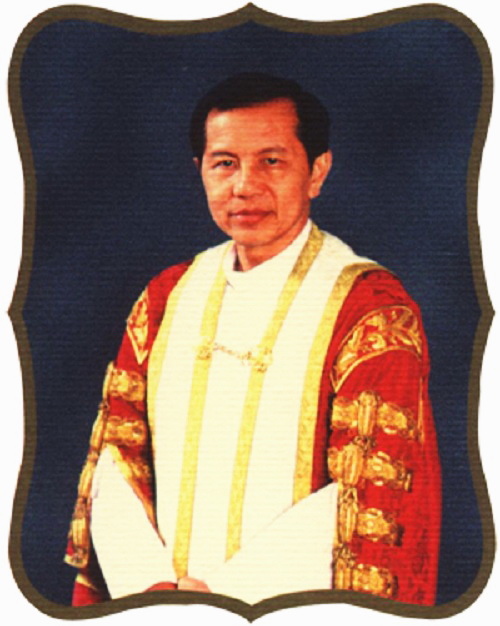
Rev. Bro. Bancha Saenghiran,
f.s.g., Ph.D.
President
We meet tonight, brought together by the Horizons 2009 event, as friends, of each other and of a beloved institution. As students, faculty, administrators, alumni, or merely supporters we are united in our commitment to the continued development of the Graduate School and an expansion of the role that it plays in the lives of its students and in our society. As we take advantage of this opportunity to share and discuss our thoughts and ideas about the future of the Graduate program, we all should be aware that this new cooperative initiative constitutes just one more milestone in Assumption University’s history.
It is very fitting that Horizons 2009 is taking place in this year, which is also the 40th anniversary of Assumption University of Thailand, the 24th anniversary of the Graduate School of Business, and the 12th anniversary of the OD program. This is, of course, a time to celebrate but it is of course most appropriate that part of a university’s celebration of its history should involve moments of thoughtful exchanges of ideas about is own mission and how that mission could be fulfilled. It is the goal of Horizons 2009 to provide one opportunity for such reflection on the institution’s present and most of all its future.
It is also particularly fitting to have Dr. Ampon Kittiampon as tonight’s keynote speaker. As Secretary General of the Office of the National Economic and Social Development Board (NESDB), and as an architect in the planning of the Thai economy, his talk on the “Effects of the Global Economic Crisis on Thai Economy & Development Plan” will provide insight into the larger social and economic context in which our institutional mission is necessarily embedded. It can, therefore, play a particularly important component in our reflections and discussions, tonight and in the future.
This reflection will ensure that AU will continue to educate young women and men of today so that they will combine a solid awareness of fundamental principles with the dynamism and innovation needed to be successful in the world, and in fact to change the world.
I am grateful to Dr. Ampon Kittiampon for accepting our invitation to speak tonight. I wish everyone success and enjoyment. I also wish to congratulate the organizers of Horizons 2009 for their vision and for their hard work in making tonight’s gathering possible.
God be with you always.
Au President’s speech for Wai-Kru Ceremony 2011
Dear student:
Wai-Kru ceremony or paying respect to teachers is the Thai tradition which is deeply rooted in the past and is practiced in many professions. For AU, Wai–Kru Ceremony is being conducted at the start of the new academic years. It is held in high esteem and considered sacred because teachers confer knowledge, concentration and wisdom.
There are two parties involved in this ceremony: namely students and teachers. Symbolically, students participating in this ceremony advance to make a request to teachers to accept them as their students. They promise to respect and obey, and follow the instruction and advices given by the teachers. Whatever demands put forward by the teachers, they are ready to follow for their own benefits. With trust and confidence in their teachers, students will do whatever in their power to pursue truth and knowledge. In the process of learning, such disposition of trust, confidence, and respect are essential to personal growth from within and development can take place and flourish in this regard.
On the other hand, teachers accept all of you to be their students. This implies that teachers undertake the responsibility to educate you and to prepare you to be ready for the society and the world in the 21st century. They profess to commit to teaching profession. In the teaching and learning process, commitment, cooperation and collaboration of the two parties are necessary and essential to achieving the goals.
Today, you will have the opportunity to witness good examples from the recipients of the awards for excellent academic performance of the past year. Learn from them, try to outdo and excel them. Your life on campus will be years of formation through different experiences. Engage with people and environment on campus wisely.
Dear student:
Consider this Wai–Kru Ceremony to be a special event. May the spirit of Wai–Kru Ceremony live on in both our teaching and learning, in our ngagements, and in our daily living.
Allow me to thank everyone who help make this event a meaningful one.
I pray to God to grant you the wisdom to overcome difficulties that may come your way. May He bless all who teach and all who learn. May your minds be always open to the truth and the teaching of teachers with humility.
May God bless you all & thank you.
Wai–Kru Ceremony 2011
June 16, 2011
Wai–Kru Ceremony 2011
John Paul II Sports Center, Suvarnabhumi Campus
Assumption University
June 16, 2011
Administrators,
Faculty & Staff members, Alumni,
Student Organization, and Students
This academic year 2011 marks a special event in the Thai history. It’s the 84th Anniversary of His Majesty the King Bhumibhol Adulyadej. We, members of AU family, have every reason to rejoice. The government has announced this calendar year 2011 to be the year to honor our King in a special.
For us at AU, as we mark the beginning of our academic year with Wai–Kru Ceremony, it is fitting and appropriate for us at this moment to have first Wai–Kru Ceremony for Teacher of the Land. For His Majesty the King is considered to be a great teacher for our lecturers to imitate and all of us here to follow his teachings and model after him. From January 1 to December 31, 2011, Thailand will celebrate the 84th birthday anniversary of His Majesty King Bhumibol Adulyadej.
For Thai, the 84th anniversary is considered an important milestone of life. It’s the completion of the seventh 12–year cycle. It’s special celebration on this occasion. The cabinet, during its meeting on December 21, 2010, endorsed the proposal by the Ministry of Education to present His Majesty the King with the title of the “Teacher of the Land” to honor His Majesty in commemoration of his 84th birthday anniversary.
His Majesty won the title “Teacher of the Land” for several reasons. From the life and work of His Majesty, he has a special interest in education development. He sets himself as a clear example of life–long learning. His royal addresses and writings keep reminding all involved in the importance of learning. Also his royal activities, work plans, and projects aim at demonstrating the solving of problems and at creating learning communities for the development of the quality of life of the Thai people.
(i)Regarding formal education, His Majesty established Chitralada School in 1955, where young royal children, children of courtiers, and children from the general public could study together.
(ii)Having learned about the lack of educational opportunities among disadvantaged children during his visits to rural remote areas of the country, His Majesty has instructed the setting up of schools and has given them support. A total of 104 schools are under royal patronage and guidance.
(iii)His Majesty has granted many scholarships for students wishing to study abroad with the hope that they will work for the country upon their graduation to assist in the development of the country as a whole.
(iv)Concerning non-formal education, His Majesty set up Phra Dabos School in 1975 to provide vocational training in various fields for people who lack the means necessary to enter formal schools. Open to everyone, the project began by providing electronics and radio training at the Royal Household Bureau in Bangkok, and it was later expanded to include radio repair, welding, construction, and electrical skills in its curriculum.
His concept of education involves the roles and duties of educators and teachers. In his view, educators are obliged to “Make good learners,” so that they are able to earn their livelihood and be able to contribute to the country.
In recognition of His Majesty’s dedication development, His Majesty deserves the title of the “Teacher of the Land.”
During his active years, His Majesty travelled to every nook and corner of Thailand to teach the Thai people how to earn their living and how to lead a life of quality. He is very practical in dealing with people. His Majesty taught them theories and put what he taught into practices. This can be seen from His Majesty’s “New Theory,” “Sufficiency Economy,” to mention just a few. He sees the potentials in his people and encourages their development. His Majesty taught people how to develop from both without and also from within. His teaching methodology covers all teaching dimensions, either it be theory, practice, research, and innovation. He integrated them in teaching people to uplift their standards of living for the learning to help themselves. The King moreover goes beyond what is expected. He made follow-ups of all what he engaged with people. He is a prime example of what he taught to them in all aspects of life.
Though His Majesty has been in Siriraj Hospital since September 2009 under the close supervision of medical personnel, yet His Majesty continues to teach his people through his words and work.
His Majesty has a sense of purpose in the teaching of his people. He can make an incredible difference in the life of his people. The Thai people, as the King’s students, are also aware that their teacher care for them and want to teach them, that’s why they are more apt to listen and to learn, for people (students) can sense the heart of this teacher, their King.
As the Teacher of the Land, His Majesty has made impact on the life of his people, He inspires people to reach their aspirations. Many are excellent teachers of subject material of facts and figures, but His Majesty makes a difference in their lives. He is great in the way he teaches and in the way he interacts with people.
His Majesty can achieve this title the “Teacher of the Land” through the path of devotion, the road of sacrifice, listening to people with patience, listening to the heart.
His Majesty has the art of encouragement, trust and confidence in his people. He pursues his goal with determination. He also has the words of wisdom and sometime filled with humors.
He is a source of inspiration
a source of joy & peace,
a source of hope & serenity,
a source of wisdom.
He is rightly our Teacher, the Teacher of the Land. We all pay homage to His Majesty the King, accepting him as our teacher. We promise to follow his teachings so that our lives will be transformed as proud citizens of the country. We wish His Majesty good health, good rest and long life to live with his students and continue to teach us to become good assets of the country.
In honor of His Majesty, King Bhumibol Adulyadej, Teacher of the Land.
On Wai–Kru Ceremony
at John Paul II Sports Center
By AU Family
June 16, 2011
Congratulation Message
Rev.Brother Bancha Saenghiran, f.s.g. Ph.D.
President of Assumption University
 |
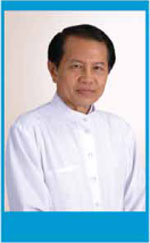 |
This year on November 3, 2013 is a special year. The Foundation of Saint Gabriel in Thailand has the privilege of celebrating the Silver Jubilee of Religious lives for our three Brothers: Bro.Chainarong Huadsiri, Bro.Monthol Prathumarach, and Bro.Chamana Laoruckphon. On this very same day, it is also the Golden Jubilee of Religious lives for Bro.Leochai Lavasut and Bro.Amnuay Yoonprayong and special celebrations are being organized to honor them.
On this special occasion, I would like to congratulate each and every one of our Brothers for being faithful to their promises made in their first professions. Each vowed to have Christ as the center of his life. They have likewise lived with Christ as the center of their lives. The celebration this year is also a time for each to recommit themselves once again to follow the ideals they have adopted and made their own lives dedicated ones of spirituality. At the same time, we give thanks to God for His unfailing love He has unconditionally shared with His servants. The event we celebrate can be considered as God’s very event in that He manifests His fidelity
despite our unfaithfulness. The jubilee is meaningful because we witness in the lives of the celebrants God’s assurance of His endless faithfulness and love. Religious profession is the most significant act of the meeting between God and the individual Brothers who offer themselves to Him and His creation.
Let us together give praise and glory to God for the journeys our Brothers continue to take in the Lord’s vineyard. We celebrate their Silver Jubilees and Golden Jubilees respectively, today in jubilation and profound thanksgiving for their God-filled lives, striving after perfection.
May God grant them abundant graces so that they continue to serve Him and the whole humanity in the contents of their lives and in their capacities given by God alone, faithfully.
Happy Anniversary!
Rev.Bro. Bancha Saenghiran, f.s.g., Ph.D.
President, Assumption University
สารจาก ภราดา ดร. บัญชา แสงหิรัญ
หนังสือ 80 ปี เจษฏาจารย์ ประทีป มาร์ติน โกมลมาศ ฝากไว้ในแผ่นดิน
เมื่อเอ่ยถึง ภราดา มาร์ติน ประทีป โกมลมาศ ทุกคนที่รู้จักท่านจะต้องนึกถึงโรงเรียนเซนต์คาเบรียล และ มหาวิทยาลัยอัสสัมชัญ (ABAC) แต่ระหว่างสองสถาบันการศึกษานี้ ท่านจะถูกกล่าวขานมากที่สุดเกี่ยวกับมหาวิทยาลัยอัสสัมชัญ เพราะตลอดชีวิตนักบวชในการรับใช้พระศาสนา และการจัดการศึกษาของท่าน ท่านใช้ชีวิตในการทำงานที่สถาบันการศึกษาแห่งนี้นานที่สุด และได้ฝากชิ้นงานสถาปัตยกรรม ปฏิมากรรมและจิตรกรรมอันเป็นอมตะไว้กับแผ่นดินไทย คือ การก่อสร้างมหาวิทยาลัยอัสสัมชัญ วิทยาเขตสุวรรณภูมิ ขึ้นมาจากพื้นที่อันเป็นทุ่งนา และการทำการเกษตรที่ไม่มีใครนึกฝันว่าจะกลายเป็นชุมชนการศึกษาที่เจริญก้าวหน้าอย่างรวดเร็วจนกลายเป็นสถานที่ศึกษาดูงานด้านการบริหารอุดมศึกษาของประเทศ
ในปีการศึกษา 2556 มหาวิทยาลัยอัสสัมชัญได้กำหนดจัดงานเฉลิมฉลองให้กับบราเดอร์ มาร์ติน ในโอกาสที่ท่านมีอายุครบ 80 ปี วันที่ 22 ธันวาคม 2556 งานแรกจะเป็นงานที่เชิญคณะสงฆ์ คณะนักบวชชาย หญิง มาร่วมโมทนาคุณพระเป็นเจ้าที่ได้โปรดประทานบราเดอร์ มาร์ติน มาเป็นของขวัญให้พระศาสนจักร คาทอลิกประเทศไทย และเป็นของขวัญให้กับภราดาคณะเซนต์คาเบรียล ซึ่งจะจัดขึ้นในวันที่ 11 พฤศจิกายน 2556 ตรงกับวันฉลองนักบุญ มาร์ติน เดอร์ ตูรส์ นักบุญองค์อุปถัมภ์ของท่าน และในวันที่ 24 พฤศจิกายน 2556 จะมีการจัดงานเลี้ยงฉลองแสดงความยินดีต่อบราเดอร์ มาร์ติน อันเป็นการร่วมมือกันระหว่างศิษย์เก่าของสถาบันในเครือมูลนิธิคณะเซนต์คาเบรียล
โดยส่วนตัวแล้วข้าพเจ้าได้รู้จักบราเดอร์ มาร์ติน เมื่อครั้งที่ท่านได้ไปประจำอยู่ที่บ้านฝึกอบรมของยุวชนที่สมัครมาทดลองใช้ชีวิตขั้นต้นที่โรงเรียนอัสสัมชัญ ศรีราชา ท่านมาช่วยสอนการเขียนเรียงความภาษาอังกฤษ ข้าพเจ้าจึงถือได้ว่าเป็นศิษย์ของท่านตั้งแต่ยังเป็นเด็กอยู่ต่อมาได้พบท่านอีกครั้งหนึ่ง เมื่อท่านเป็นเจ้าคณะเซนต์คาเบรียลแขวงประเทศไทย ท่านนอกจากจะสนใจ ในด้านการศึกษาแล้วยังเป็นศิลปินที่ชอบดนตรี และในพิธีทางศาสนาท่านจะส่งเสริมให้มีการร้องเพลงประสานเสียงในโอกาสต่างๆ
ท่านเป็นผู้มีความคิดยาวไกล และวางแผนเพื่อให้บรรลุเป้าหมายที่วางไว้ได้ พยายามเตรียมบุคลากรนักบวชทั้งทางด้านวิชาการและชีวิตนักบวช ได้ส่งเสริมนักบวชตามพรสวรรค์ที่แต่ละคนมี และตามจิตตารมณ์ของผู้ก่อตั้งคณะฯ ท่านเป็นผู้ที่มีวิสัยทัศน์กว้างไกล เมื่อท่านมอบหมายงานให้ทำแล้ว ท่านให้ความไว้วางใจผู้นั้น พฤติกรรม ความคิด และวิสัยทัศน์ของท่านสะท้อนถึงการมีภาวะผู้นำแห่งการเปลี่ยนแปลงและผู้นำที่มีบารมี (Charismatic and Transformational Leadership) ตามที่ Andrew J. Dubrin (2013) กล่าวไว้ทุกประการ คือ ท่านเป็นผู้นำและทำให้เกิดการเปลี่ยนแปลงอย่างขนานใหญ่ในมหาวิทยาลัยอัสสัมชัญ เพราะท่านเป็นผู้นำที่มีลักษณะพิเศษและเป็นผู้นำแห่งการเปลี่ยนแปลงในขณะเดียวกัน มีวิสัยทัศน์ที่กว้างไกล (Visionary) มีความสามารถในการสื่อสารให้ผู้คนที่เกี่ยวข้องได้เห็นและเข้าใจในสิ่งที่ท่านได้วาดฝันไว้ (Masterful Communication Skills) และสร้างแรงบันดาลใจให้ทีมงานเกิดความรู้สึกว่าเราสามารถจะทำได้สำเร็จ (Make Group Members Feel Capable) มีพลังและมุ่งมั่นในการทำงาน (Energy and Action Oriented) มีบุคลิกภาพสุภาพและอบอุ่น (Warmth) โดยท่านใช้วิธีการกระตุ้นให้เราเกิดการเปลี่ยนแปลงหลายประการ เช่น ส่งเสริมให้ผู้คนเกิดความตระหนัก (Raises People’s Awareness) ให้มองข้ามผลประโยชน์ส่วนตน (Look Beyond Self-interest) ช่วยให้ทุกคนที่เกี่ยวข้องบรรลุถึงความสำเร็จแต่งตน (Self-Fulfillment) และพร้อมที่จะเปลี่ยนแปลง (Need for Change) โดยมุ่งถึงความสำเร็จหรือเป้าหมายที่ยิ่งใหญ่ (Committed to Greatness) และสร้างความไว้วางใจซึ่งกันและกัน (Build Trust) ด้วยภาวะผู้นำเช่นนี้ จำทำให้มหาวิทยาลัยอัสสัมชัญเจริญก้าวหน้า และมีชื่อเสียงทั้งในประเทศและต่างประเทศ
อันที่จริงแล้วในฐานะของความเป็นนักบวช เรามีโอกาสได้พบปะสังสรรค์กันบ่อย แต่ในการพบปะที่ข้าพเจ้าพูดถึง เป็นการพบปะที่ต้องทำงานร่วมกัน และอาศัยอยู่ใต้ชายคาเป็น Community เดียวกัน ต่อมาข้าพเจ้าได้มีโอกาสมาทำงานร่วมกันเมื่อท่านได้มาดำรงตำแหน่งอธิการบดีของมหาวิทยาลัยอัสสัมชัญ และข้าพเจ้ามารับตำแหน่งรองอธิการบดี จากการที่ข้าพเจ้าได้มีโอกาสอยู่ใกล้ชิดกับบราเดอร์ มาร์ติน ทำให้รู้จักนิสัยใจคอของท่านพอประมาณ ได้เรียนรู้ความคิดและวิธีชีวิต ไม่ว่าจะเป็นชีวิตการทำงาน ชีวิตนักบวช ชีวิตสังคม แม้แต่ชีวิตส่วนตน ไม่ว่าจะเป็นการเล่นกีฬา การพักผ่อนหย่อนใจ สิ่งเหล่านี้ได้ซึมซับหล่อหลอมและมีอิทธิพลต่อข้าพเจ้ามาก ท่านเป็นต้นแบบ (Role Model) ให้ได้ศึกษาเรียนรู้อย่างน่าสนใจ ในวงสนทนาท่านนำเรื่องที่ท่านอ่านมา หรือเรื่องจริงที่ท่านได้พบเห็น มาตั้งเป็นประเด็นเพื่อแลกเปลี่ยนความคิดเห็นอยู่เสมอ ท่านเป็นผู้มีใจโอบอ้อมอารี และเอาใจเขามาใส่ใจเรา ชีวิตของท่านเป็นชีวิตที่น่ายกย่องสรรเสริญ เพราะท่านมิได้ทำคุณประโยชน์ให้กับคณะเซนต์คาเบรียลแขวงประเทศไทยอย่างเดียว ท่านยังช่วยประเทศไทย และช่วยศาสนจักรคาทอลิกในประเทศไทยในรูปแบบต่างๆ กันโดยไม่คำนึงถึงความยากลำบากหรือเหนื่อยยากใดๆ จวบจนบัดนี้ บุคคลที่มีค่าไม่ว่าจะอยู่ไหน ในตำแหน่งใด ก็จะเป็นคนที่มีคุณค่ากับคนที่อยู่รอบข้างเสมอ และนี่ คือ บราเดอร์ มาร์ติน!!
ในโอกาสที่บราเดอร์ มาร์ติน มีอายุครบ 80 ปี ข้าพเจ้าจึงต้องขอบคุณพระเจ้าที่ได้มอบบราเดอร์ มาร์ตินให้เป็นของขวัญอันล้ำค่าให้กับข้าพเจ้า จวบจนบัดนี้ ท่านยังให้คำปรึกษาอยู่ตลอดเวลา ขอพระเจ้าจงอำนวยพรให้บราเดอร์ มาร์ติน จงมีสุขภาพพลานามัยที่แข็งแรงได้ปฏิบัติพันธกิจของพระเจ้าสืบไป
ภราดา ดร.บัญชา แสงหิรัญ
อธิการบดีมหาวิทยาลัยอัสสัมชัญ
